Powering next generation aero engines
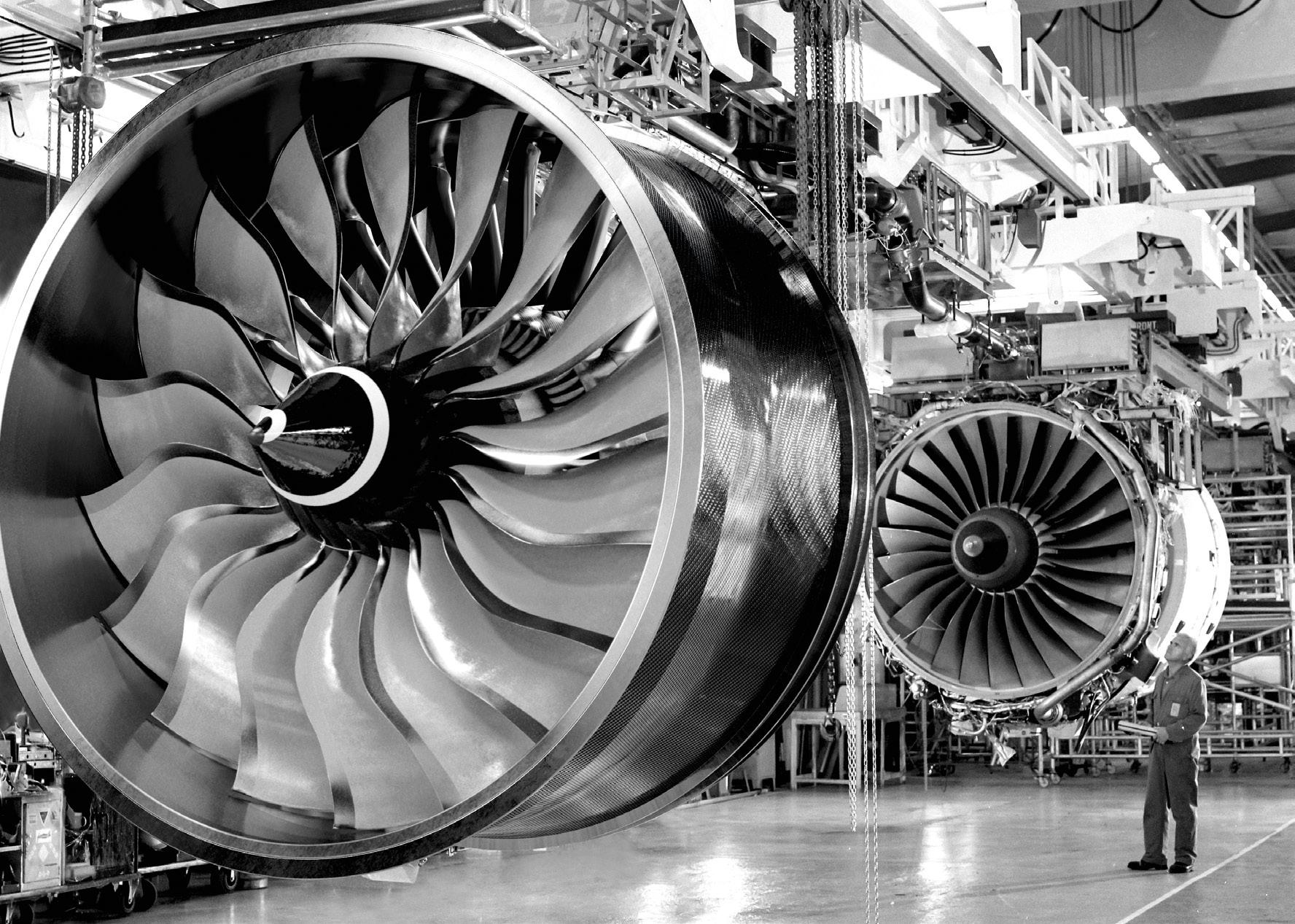
Also in this issue:
Digital: eating our own dog food
Toyota drives ‘green’ future propulsion
Harnessing the power of data science


Also in this issue:
Digital: eating our own dog food
Toyota drives ‘green’ future propulsion
Harnessing the power of data science
As an advanced manufacturing research centre, it is hard to disagree with that statement. Or indeed that 2022 was a tough and turbulent year for the UK. The headwinds facing manufacturing remain hard and steadfast in 2023: rising energy costs; rising employment and training costs as manufacturers strive to attract and retain talent; a labour shortage; risk to competitiveness due to spiralling production costs, material shortages and supply chain disruptions.
But we continue to ride out the rollercoaster of change.
When former Airbus senior vice president Katherine Bennett, took the helm of the High Value Manufacturing (HVM) Catapult in 2021, she knew putting advanced manufacturing at the cornerstone of our future economy wouldn’t be an easy ride post-pandemic and in a climate emergency. But her belief has been unwavering: the UK needs to become an industrial, global superpower.
The HVM Catapult has built strong foundations, which will be vital as we face the challenges of the next decade, but to do more and become that superpower once again means more investment - investment in R&D expenditure, investment in the sector’s net zero journey; investment in the skills needed for a future economy.
The MakeUK/PwC report shows that it is people and skills that are on manufacturers’ minds who, despite the heady challenges they face, continue to invest in their businesses. The report, which surveyed more than 200 senior manufacturing executives on their outlook for 2023, found that more than half plan to increase investment in people in the coming year; with 41% intending to increase investment in apprenticeships and 36% looking to put more into training programmes for new recruits.
It is that investment in people, and ultimately, culturewhich sits at the heart of our CEO Steve Foxley’s message in this issue of the AMRC Journal. He believes it is in the
teeth of so much external churn, and the tight grip of circumstances, that our culture is most important. It sits at our core and is our engine for change. Our engine for how we operate and connect. Our engine for innovation and impact.
In this issue, we celebrate some of the technical innovations which our people are delivering to help restore manufacturing as the engine for economic growth.
We delve into digital twins in our interview with AMRC expert Jonathan Eyre, who explains why they matter to industry and what the future holds; and we put the headlights on AMRC Cymru which is working with automotive giant Toyota to accelerate the decarbonisation and digitalisation of the transport sector through hydrogen fuel cell assembly.
You can read more about our collaboration with BAE Systems on Future Air Support to drive digital innovations into the maintenance of aircraft to reduce costs, improve efficiency and lower carbon emissions; and how we helped ten small companies in Denbighshire through digital transformation projects for their products and processes, using a suite of smart technologies like digital simulation, automation, vision systems, mechanical testing and additive manufacturing.
The work we have done to support the development of the Rolls-Royce UltraFan proudly dominates the cover of this issue. UltraFan is the world’s largest next generation aero engine demonstrator designed to support sustainable air travel. In the following pages, we take a closer look at how the AMRC’s adaptive machining expertise has helped Rolls-Royce deliver on a real engine for change and growth, one that promises to transform flight and set new benchmarks in efficiency, environmental performance and precision engineering.
Katia Harston EditorWant to know more about the latest innovations, news and insights from the AMRC? Sign up to our newsletter: amrc.co.uk

‘The UK manufacturing sector must be the engine for economic growth’. That was the opening line of the Cost, competitiveness and confidence 2023 executive survey released earlier this year by MakeUK and PwC.
The first commercial prototype of an innovative solar ‘tree’ is being developed by the AMRC.

of the transport sector by optimising hydrogen fuel cell assembly.

A novel prototype machine developed by an industrial consortium that includes the AMRC. What
Dr Andy Bell, sustainability theme lead for the AMRC, discusses the parity between the AMRC’s work on sustainable manufacturing and the role industrialists like Sir Titus Salt played in the 18th Century. Future
The AMRC is working with BAE Systems to drive digital innovations into the maintenance of aircraft to reduce costs, improve efficiency and lower carbon emissions.


 By Steve Foxley, CEO, AMRC
By Steve Foxley, CEO, AMRC

It is hard to think of a time when we have been more tested as an organisation, as communities and as individuals. For me, that is when culture comes to the fore.
We emerge from a COVID pandemic that has taken hundreds of thousands of lives, changed how we behave and how we do business. There is a painful and extremely worrying, ongoing war of attrition in Ukraine. We are operating in the teeth of economic uncertainty and cost increases that impact upon all of our lives and the choices we make. Our climate is vulnerable and changing. Our inboxes are busy and getting busier. This trend is not reversing anytime soon.
These are the conditions we navigate
and operate within and can serve to sap confidence in ourselves, our organisation and wider community. It is in these moments of challenge and change that our culture is most important. It sits at our core and is the reason that I have for a long time subscribed to the Paul Drucker totem that culture eats strategy for breakfast.
In this tight grip of circumstances, I am immensely proud of all that we have achieved. We have effectively responded to some of the challenges presented and continue to show resilience and adaptability when faced with the unexpected. As individuals, I know that many have been profoundly affected by the pandemic in particular, but also by
challenges in the workplace and cost of living pressures. The demand for our services has increased across a breadth of manufacturing and technology challenges. We are rightly seen in our locations as a vital driver of future economic growth. We are having an impact, which makes us a magnet for those thinking about future policy. This thrives not just on our technical acumen, but how we work as an organisation spread across groups and geographies.
We are delivering. Whether on our financial metrics or the outcomes desired of our industrial partners, we are meeting and often exceeding expectations. Our skills and capabilities are enjoying increased
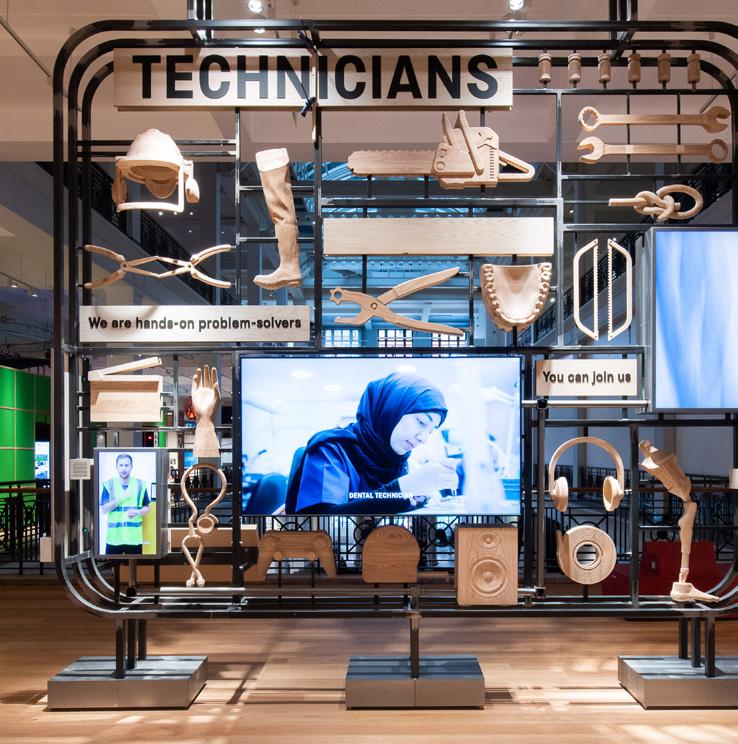

We focus most of our attention on technology. The developments in machining, composites, castings or automation. The improvements we bring in capability; the impact and the opportunity for growth across multiple firms, sectors and places. But for this edition of the Journal, I want to talk about culture.Image credit: The David Sainsbury Gallery © Science Museum Group
450 people
Mood indicator score: feeling either excellent or good at work
9
core competencies across facilities in South Yorkshire, Lancashire and North Wales
36 nationalities +/- 90%
Our churn rate is 15%
953 STEM Ambassador hours to 24 schools
More than 100 engagements with
2,714 children
demand. With our centres in Lancashire and Broughton, we are spreading our wings into fresh manufacturing challenges, building new capabilities and working with a greater array of companies with manufacturing challenges. Alongside this, we are improving our organisation and the spread of impact we are having in the places we operate. In the teeth of so much external churn, I am thrilled with how we are developing our organisation to be more effective in how we operate, more transparent and driving our wider external impact: Our digital transformation. As we regularly advise companies, understanding data can support better decision-making and ultimately better outcomes. Through our adoption of digital tools, we are gaining a much better understanding of the AMRC. Our project management tool of Harbour is giving us a single version of truth across the hundreds of ongoing innovation projects, which we can share in real time with our collaborators and partners. STEM. Illuminating the value of science and engineering to the school children across South Yorkshire, Lancashire and Wales is a key priority for us. Our STEM engagement is a vital part of our mission. Whether we are encouraging girls to stay longer in STEM subjects with AMRC role models they can look up to, or providing focused classroom activities around core principles of engineering, our team are bringing to life opportunities that may not otherwise be clear. Last year we provided 953 STEM Ambassador hours to 24 schools, with more than 100 engagements with 2,714 children. This involved a mixture of in-school activities, site tours, work
experience and large events such as MACH 2022 and North Star, which featured Prof Brian Cox.
At the National Science Museum our AMRC engineers are standing shoulderto-shoulder with heroic key workers from the NHS and the geniuses who make the magic happen in Marvel superhero movies in a new gallery exhibition at the Science Museum in London, celebrating the vital role of technicians. Visitors can experience the work of technicians and engineers at the AMRC, by testing innovative designs using computer-aided design (CAD) and experimenting with simple coding to optimise the movement of a robotic arm, watching it in action in a task inspired by the use of robotics in recycling facilities. The gallery allows visitors to hear the inspirational stories of real-world technicians. Huge illustrations of engineers Rebecca Wright and Charles Oglesby at work adorn the walls, alongside bespoke exhibits that were created with the expertise and support of our technical leads David Kay and John Halfpenny. To have our people, from apprentices right through to project engineers and technical experts, involved in such an important gallery at a national museum - one that attracts millions of visitors every year from across the world - is a real pride point in
our AMRC story and our role in encouraging the talent pool of tomorrow.

Resilience matters. I know that day-to-day experiences of work are not a parade of highlights. It can be disruptions, change, often unpredictable and too often a litany of frustrations. I am proud that despite the pressures, we have been resilient and grown stronger. Not bounced back, but forward. Colleagues and friends have left the AMRC, and we have welcomed new ones. The results of the staff survey and our mood indicator tool signals that we are pointing in the right direction. We have a lot to be proud of.….. but there is a lot more to do.
If we take a longer view, our organisation has changed. We all know that we have grown enormously in capabilities, staff numbers, square footage of buildings and revenue, but so has our complexion and outlook. If we are going to have the impact we aspire to - leaders, software makers, grant writers, data scientists, project managers, storytellers, administrators and events specialists are a critical part of our team.
This array of talent helps us to innovate better technology, but vitally to better connect with our funders, our partners and our communities.
In the teeth of so much external churn, I am thrilled with how we are developing our organisation to be more effective in how we operate, more transparent and driving our wider external impact.
The concept of a digital twin has been in practice for the past few decades, but it wasn’t until 1998 that the phrase was first mentioned – which referred to a digital counterpart of American Emmy-winning actor Alan Alda’s voice.
In the manufacturing world, discussions around digital twins began in literature in 2005, when the Institute of Electrical and Electronics Engineers (IEEE) wrote an article on ‘The web of augmented physical objects’
However, Jonathan Eyre, senior technical fellow for digital twins at the AMRC, says it has only been within the last five years that people have really started to exploit digital twins and what they can enable, due to developments in concepts such as the Internet of Things (IoT) and the cloud that has made them achievable.
“Digital twins are about observing the world we live in by synchronising it with digital representations to enable datadriven decisions,” says Eyre, who is coming
up to having almost a decade of AMRC experience under his belt. “It is more than just a computer-aided design model or a simulation – digital twins are an approach to better understand what actual assets and processes are doing to be able to change and improve their implementations.

“Some descriptions present digital twins as assimilating data into dashboards; however, this is just a starting point. Having the ability to predict and have remote control would be a further advancement, but we need to set expectations even higher towards integrating digital twins to other such twins across supply chains and other organisations, referred to as federated digital twins.”
For Jonathan, it was the element of problem solving that got him fired up about a career in engineering. He studied

Jonathan Eyre tells Chloe Rothenburg about the AMRC’s ‘gold standard’ work on digital twins, its purpose, importance to industry and what the future holds.

aerospace engineering at the University of Sheffield and came to the AMRC in 2015 where he joined the team at Factory 2050, settling into a role within control systems and software.
“One of the key reasons I took up a placement at the AMRC was to find what took my interest the most within engineering,” he says. “At this time, the organisation was expanding its digital group, focusing on applications of digital technologies and software development, which I moved across to, looking at immersive applications and information flows.
“These areas grew my understanding of manufacturing and how complex problems need to be solved with better use of software to make decisions, and with the right information available at the right time. This led me into the area of digital twins, which I’ve been progressing and supporting research activities within ever since.”
There were lots of discussions in 2020 around trying to understand the hype around digital twins, something Jonathan says the AMRC was keen to help shed light on.
He added: “We brought together individuals from across the AMRC to collate our best articulation of everything we had learned and had been doing in this space to date.”
In October 2020, the AMRC produced the ‘Untangling the Requirements of a Digital Twin’ white paper, to produce a consistent definition for a digital twin and break down its components with classifications and practical examples. This was quickly adopted as the High Value Manufacturing (HVM) Catapult definition due to the clarity the AMRC had achieved and the rigour produced through showing their approach in defining the terms in the way it had. “The impact this achieved was beyond what we had hoped for,” says Eyre. “Whilst our primary audience was the manufacturing sector, we did keep it broad where possible so it could apply as far as possible.

“What this caused was the definition being utilised beyond manufacturing, such as in the built environment; oil and gas to name two. It was a pleasure to be able to see conversations maturing in understanding from what we had produced, so much so that our work is still being referred to as
the ‘gold standard’ in understanding how to think about digital twins.”

The AMRC is now involved with a roster of projects that range in scope but centred around a digital twin approach.
Jonathan said that some of this research includes looking at a best practice guide for shopfloor integration of IoT, such as Factory+, which provides an open framework to standardise and simplify the way that data is extracted, transported, stored, processed, consumed and protected across a manufacturing organisation.
Eyre says: “Our machining team has been looking at self-optimising feedback for a machine tool, utilising online simulation and live data within the control loop –and our manufacturing intelligence team has been continuing to explore how synchronised data from manufacturing systems enables benefits to production planning and optimisation.”
The AMRC is also working with the HVM Catapult and other leading organisations on the Apollo Protocol, a project that has been initially looking at how the built environment, manufacturing and
technology sectors can break the divide and unlock the benefits of digital twins. In addition, it’s calling for a common language across all sectors and industries to help the UK fully deliver the potential digital twins can provide in terms of value for productivity and sustainability.
According to Eyre, they enable decision making with quality data at the fingertips, which can predict into the future and make the best use of what exists in the real world – and primarily drives cost-reduction and time savings.
“By having data intuitively understood and managed, larger step-changes in overall performance can look towards other aspects such as sustainability,” he says. “These are important, as most of the analysis is conducted virtually, meaning it’s done before anything new is built beyond what already exists or anything is changed.

“Another key driver is to improve efficiency and reduce non-value-added time of operations, be that business processes or shopfloor management. Having the ability to understand system behaviours allows better management through predictive maintenance leading to risk reduction over traditional reactive work.
“Overall, digital twins are about organisations making better decisions and increasing the performance of what we are trying to achieve in the real
world. But we must not lose sight of UK manufacturing being a complex system of systems, needing individual organisations to manage their individual machines and workforce – but to also provide information across supply chains to understand the knock-on effect of delays on the overall schedule.”
To date, solutions for digital twins remain in their infancy, and organisations seeking the benefits are still considered early adopters. However, the future for digital twins is looking bright and looking forward, says Eyre, who points out that systems need to push ahead from deployments being focussed on assimilating data – which is currently integrated with a specific business software tool for analysis or monitoring purposes (typically a dashboard or predictive machine maintenance) – to needing forward systems to work together seamlessly. This is referred to as system interoperability and driven by ontologies, which requires a greater comprehensive understanding of our world in the digital space.
“For me, digital twins are about being able to play around in a safe, virtual environment, to see what the cause and effect is of changing parameters without affecting anything,” he says. “It’s also about having the trusted data source available to visualise what has previously happened, what could happen and be able to collaborate with other engineers with supporting decision tools, such as augmented intelligence to help choose the best future.”
Jonathan stresses that interoperability is critical, not to just enable digital twins, but also to allow files to be easily exchanged from one format to another at a click of a button, rather than a one-off bespoke translation.
In a final thought, he says: “Science fiction has shown us some great future looking interfaces with technology – and digital twins have become a part of that space to help solve some of our world’s greatest challenges now.”
Digital twins are about observing the world we live in by synchronising it with digital representations to enable data-driven decisions.
Digital transformation is the process of using technology to fundamentally change how the AMRC operates and delivers value to partners. It involves adopting digital technologies to improve efficiency, boost growth and revenue, and stay competitive in the digital economy. This includes changes to business models, processes and culture, as well as the adoption of new technologies.
The ultimate goal of digital transformation is to create new opportunities for growth and innovation, while also reducing costs and improving customer experiences. The current digital transformation activities are an attempt at ‘eating your own dog food’ - a term used when a company uses its own products or services for its internal operations.


The digital transformation strategy is integrated with the AMRC’s digital strategy. The AMRC’s digital strategy is formed around three key pillars to take into consideration the processes and experiences of staff and partners for operational and research activities. These pillars are:
• Single source of truth
• Smart connected factory research
• Identification of disruptive digital technologies
While all three pillars are important, our own transformation mainly focuses on the first pillar, the single source of truth. A single source of truth is important for digital transformation because it ensures that all stakeholders are working with accurate and consistent information.
During the past 20 years, the AMRC has helped drive technology adoption for many of its partners but has often overlooked its own internal digital transformation. Ryan Diver, chief engineer for digital transformation at the AMRC, explains why that is changing.Ryan Diver, chief engineer for digital transformation at the University of Sheffield AMRC.
The ultimate goal of digital transformation is to create new opportunities for growth and innovation, while also reducing costs and improving customer experiences.

This is particularly important when implementing new systems or processes, as it helps to minimise errors and inconsistencies that can arise from using multiple, disconnected sources of data. Additionally, a single source of truth can help to improve efficiency and decisionmaking by providing a clear and accurate view of the organisation’s operations and performance.
Phase one of the single source of truth work is data, data and more data. The AMRC’s data is currently siloed across many systems, making it difficult to gain insights and make decisions upon.

Similarly to creating a single source of truth, the AMRC is focusing on a unified project management process. Previously each group worked independently, evolving its own systems and processes for managing projects. This led to a lack of consistency when engaging with different groups across the AMRC and a lack of internal integration.
At the beginning of 2022, a project management working group was formed in order to standardise the process for all groups. A unified project management (UPM) approach was taken which includes the integration of all aspects of project management, including planning, execution, monitoring and control, and closure into a single, cohesive system.
The main advantages of a UPM approach are:
Improved efficiency: streamlining of all project management processes, eliminating duplication and reducing the risk of errors.
Better communication: facilitating communication among team members, different groups and partners, providing a single source of truth for project information.
Increased visibility: providing real-time visibility into project progress, enabling managers and partners to identify and address potential issues before they become problems.

Greater collaboration: supporting collaboration among team members and partners, fostering a culture of teamwork and shared responsibility.
Enhanced decision-making: providing managers with the data and insights they need to make informed decisions, helping to ensure the success of the project.
Better resource allocation: helping managers to optimise resource allocation, ensuring that the right resources are in the right place at the right time.
Increased predictability: enabling managers to identify and mitigate risks, reducing the likelihood of project delays and cost overruns.
Better customer satisfaction: able to improve communication, collaboration and transparency with partners, resulting in better customer satisfaction.
Resource sharing: able to facilitate resource sharing across the organisation, better utilising the world-class teams. To support this UPM approach, a project management system has been developed in collaboration with Program Framework, built upon its Power Framework platform. Power Framework is a collection of Microsoft products including Power Apps, Project Online and Power BI, combined together to create a portfolio management platform called Harbour.
Harbour is a digital platform that is able to exploit all of the advantages of UPM listed above. It has been developed as a collaboration between myself as chief engineer - digital transformation, Aiden Lockwood, chief enterprise architect, and Angus Williams, who is head of project management. The change has been a balance of cultural, procedural and systems development.
One element of enterprise IT which can be overlooked is the non-functional requirements. These ensure any operational IT system conforms to policies and behaviours, which are needed to maintain compliance in an ever-changing world. Often these non-functional
requirements, for example security, back-up, redundancy or availability, are retrospectively considered, but are as important, if not more so than functional requirements, which govern how a system may look or how it behaves when a user interacts with it.

At the AMRC we take data security very seriously. Data availability is essential for day-to-day operations. However, when we are required to lock down information, we are exploring advanced capabilities to ensure data is only made available to those who need it, when they require it and in a format which helps them undertake their job.
Data warehousing and reporting are essential components of any digital transformation strategy. Data warehousing refers to the process of collecting, storing, and managing large sets of data from various sources in a single, centralised location. In the context of the AMRC, this is also referred to as a data lake or, as you may have heard it called, the AMRC Data Cloud.
The data cloud allows easy access and analysis of data, enabling the AMRC to make informed decisions and improve its operations. Reporting, on the other hand, is the process of presenting this analysed data in a clear and concise format, such as through charts, graphs, and tables. Together, data warehousing and reporting provide organisations with the ability to gain valuable insights from their data, which can help them to improve their performance and achieve their business objectives. In essence, putting the information into the hands of decision-makers.
Part of the current transformation work is to define a standardised pipeline for data into the AMRC Data Cloud (data warehouse/lake), which is built upon the Databricks platform hosted in the Azure cloud. Databricks is a powerful platform for data engineering, machine learning, and analytics. It is built on top of Apache Spark, an open-source, distributed computing system that can process large amounts of data quickly and efficiently.

The Databricks platform provides a collaborative, web-based environment that makes it easy to clean, transform, and analyse data, as well as build and deploy machine learning models. With Databricks, data scientists and engineers can work together on the same platform, allowing for better collaboration and faster development.
Databricks also offers advanced security features and the ability to scale up and down as needed, making it a valuable tool for organisations, ranging from small and medium-sized enterprises (SMEs), through to original equipment manufacturers (OEMs). From an AMRC perspective, this is where we are bringing together all of the data across the organisation and the platform allows us to overlay datasets from multiple sources in order to gain valuable insights.
Reporting from the data warehouse takes the vast amount of data and presents it in a way that can be used by decision-makers across the AMRC. This is done through the Microsoft Power BI platform, a business intelligence and data visualisation tool. It is a valuable tool for organisations looking to gain insights from their data and improve their decision-making. Its ability to connect to multiple data sources, create interactive visualisations, and share reports make it a powerful tool for digital transformation. So, when we boil it down, what does this all mean - what difference will it make? Our digital transformation will be the most impactful for our own staff and, importantly, the AMRC’s industrial partners. Initially, our partners will start to see common systems being used by all staff across the AMRC, resulting in a more consistent experience. This information will include dashboards to lead meetings such as partnership engagement, project review meetings and portfolio meetings. During quarter two of 2023, the AMRC will also be launching a partner portal that will allow all partners of the AMRC to see ongoing projects, up-to-date project reports and status, and project leads for their entire portfolios.
The AMRC Data Cloud allows easy access and analysis of data, enabling the AMRC to make informed decisions and improve its operations.
 By Mrudula Jadhav
By Mrudula Jadhav
Toyota Motor Manufacturing UK has signed a deal with AMRC Cymru to accelerate the decarbonisation and digitalisation of the transport sector by optimising hydrogen fuel cell assembly.
Exciting, new advancements have been made to the Hydrogen Electric Propulsion Systems (HEPS) assembly testbed, based at the University of Sheffield Advanced Manufacturing Research Centre (AMRC) Cymru in North Wales, since work began in October 2022.
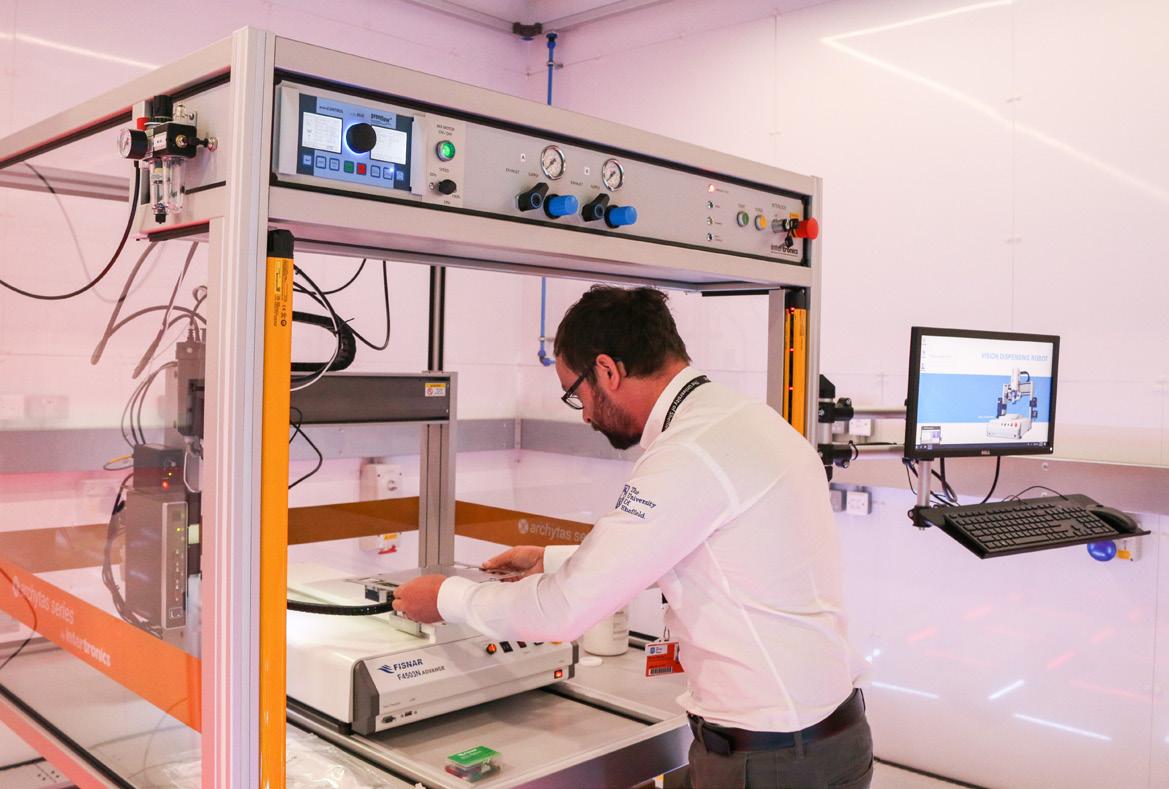
The HEPS project aims to de-risk the assembly and production scale up of hydrogen fuel cells for the automotive, aerospace and rail industries. The first iteration of the HEPS testbed consists of a reconfigurable floor, collaborative robots and other advanced Industry 4.0 technologies in a self-contained assembly area, making it ready for developing and de-risking innovative new methods of fuel cell assembly.
Building on a long-standing relationship, Toyota and the AMRC, part of the High Value Manufacturing (HVM) Catapult, are collaborating on a 12-month project where Toyota will use the HEPS testbed to assemble its hydrogen fuel cells in the North Wales facility, focusing on enabling fuel cell manufacturing in the UK. The Toyota project is funded by the Welsh Government’s Low Carbon Automotive Transformation Fund.
Lee Wheeler, senior engineer and hydrogen/ future propulsion lead at AMRC Cymru, says that working with Toyota
is an exciting opportunity for the AMRC. He said: “Toyota brings in the expertise around its manufacturing system and the fuel cell that’s currently used in its vehicles. The AMRC will play a pivotal role in the project by contributing our expertise in digital manufacturing, future propulsion, hydrogen, sustainable manufacturing and by providing the assembly testbed to perform the tests.”
Simon Foster, senior manager for production control and new business development at Toyota UK, said: “This is a brilliant opportunity to work with the
AMRC Cymru, part of a network of worldleading research and innovation centres. This exciting project allows us to develop the concept / proof for assembly of fuel cell electric vehicle (FCEV) powertrains, significantly contributing to the skill base of Toyota and the AMRC. The collaboration with the AMRC will challenge our way of thinking, allowing the development of new and innovative solutions.”
Since its inception, Toyota has been an active part of the industry steering board assembled by AMRC Cymru, which guides the work of the HEPS assembly testbed,
to ensure the work being done is relevant to industry and addresses real-world manufacturing needs and challenges. One of the recent developments in the project is the use of advanced gasket application equipment and an advanced visual metrology system to address an industrial challenge around fuel cell stack leakages. The visual metrology system stops leaks in the fuel cell by checking if the seals are applied correctly.
AMRC Cymru engineers have also worked on laser part-marking for fuel cell components. Lee explains: “Part-marking

“By combining the AMRC’s advanced manufacturing technology capability with Toyota’s world renowned LEAN manufacturing culture and methodology, we hope we can establish a benchmark for how hydrogen propulsion systems can be manufactured.”
Andy Silcox, AMRC Cymru research director.
assigns a unique code to every component to help identify and track the components, providing a digital built record of the multiple components going into the fuel cell.
“Laser part-marking allows the system to stop the process if the wrong parts are used or are being inserted in the wrong way. It also enables in-process verification, allowing us to check if the right parts are being fixed in the fuel cell in the right way, assuring its in-built quality.”
Stuart Dawson, chief engineer for hydrogen at the AMRC, said: “We’re delighted that Toyota, one of the world leaders in hydrogen fuel cell technologies, has decided to collaborate with AMRC Cymru to exploit the capabilities of the new HEPS assembly cell. “For the UK hydrogen fuel cell sector, in general, we have noticed a discontent between the high maturity levels of their product and the much lower ones for their manufacturing methods. That’s why we invested over £1m into the new HEPS cell which will allow the UK manufacturers to develop high yield, high rate, globally competitive methods of fuel cell assembly. The HEPS cells will enable these companies to scale up their production and for fuel cell manufacturing to become anchored within the UK.”
AMRC Cymru research director, Andy Silcox, said: “There is nothing like the HEPS testbed currently available in the HVM Catapult and we see it as a key capability for AMRC Cymru. There is real interest in this kind of reconfigurable assembly technology amongst businesses in Wales and the north of England.
“By combining the AMRC’s advanced manufacturing technology capability with Toyota’s world renowned LEAN manufacturing culture and methodology, we hope we can establish a benchmark for how hydrogen propulsion systems can be manufactured and pave the way for their widespread adoption as the green fuel solution for surface transport post 2030.” The AMRC Cymru team will explore how to de-risk, industrialise and scale-up the assembly of hydrogen fuel cells and electrolysers by applying advanced
manufacturing processes and the AMRC’s capabilities in automation, digital, in-process verification and design for manufacture.
Lee says that the HEPS assembly testbed ultimately aims to manufacture and assemble fuel cell/ electric powertrains in a low cost, standardised and sustainable way in a boost to the UK transport sector, helping it to get closer to its net zero ambition.
He added: “Hydrogen electric propulsion systems are a new area for the AMRC. We’re stepping into the unknown, it’s not been done before by the AMRC, but we’re
learning and leading the way for the HVM Catapult.”
AMRC Cymru is a £20m cutting-edge R&D facility that opened in 2019 to provide an open innovation centre for manufacturers in Wales. Backed by the Welsh Government, AMRC Cymru is the first HVM Catapult centre in Wales.
The HVM Catapult, of which the AMRC is one of seven centres across the UK, has funded the HEPS project which is specifically targeting seven industries: aerospace, energy generation, heavy automotive, off highway, public transport and rail.

“This is a brilliant opportunity to work with the AMRC Cymru, part of a network of world-leading research and innovation centres. The collaboration with the AMRC will challenge our way of thinking, allowing the development of new and innovative solutions.”
Simon Foster, senior manager for production control and new business development at Toyota UK.
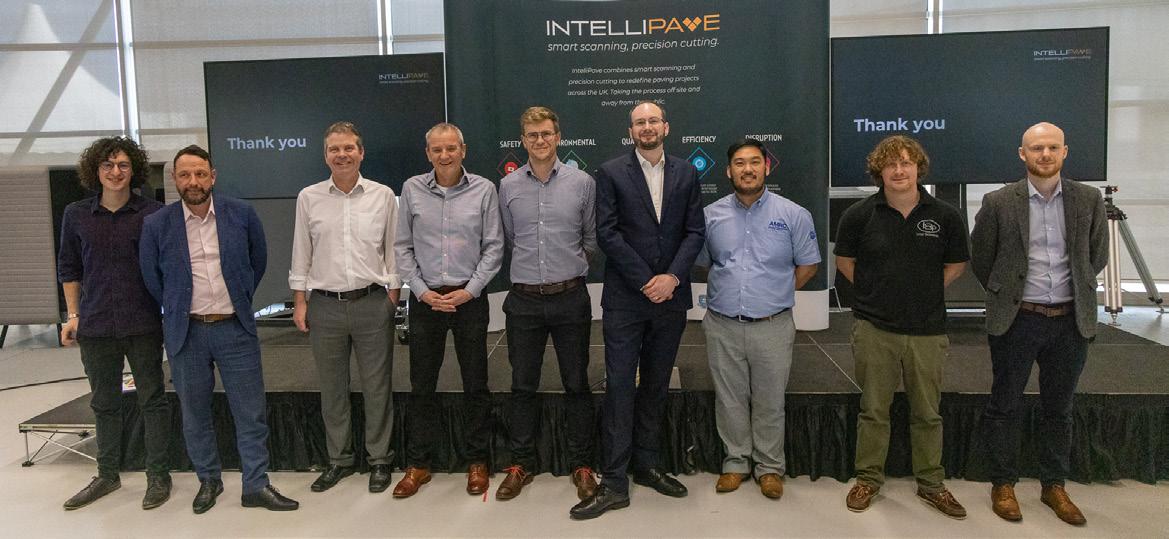 By Chloe Rothenburg
By Chloe Rothenburg
ITP Aero is one of the driving forces behind the pursuit of more sustainable aerospace solutions, aimed at developing ultra-efficient engines, as well as laying the foundations for hybrid-electric and hydrogen-based propulsion systems.
Dr Rob Mitchell, head of engineering for ITP Aero UK, said the company is collaborating with the AMRC to help it continue to push the boundaries in terms of its industrial and economic performance by making step changes in productivity, increasing competitiveness, developing new products and processes, and training new talent and skills.
“There are a number of core competencies the AMRC has, which will help increase our manufacturing strengths at ITP Aero – these include machining, integrated manufacturing, castings, design and prototyping, as well as structural testing, additive manufacturing, microscopy, metrology and manufacturing intelligence,” said Dr Mitchell.
“We’ll be able to harness these skills, expertise and technologies to drive
forward our work on key development projects for our UK and global operations, not to mention the influence that this work can have on the industry overall.”
Matt Farnsworth, commercial director at the AMRC, said he sees a huge level of synergy between ITP Aero’s long-term technology development needs and the AMRC’s current core competencies and future strategic capability areas.
He added: “ITP Aero’s standing in the aerospace manufacturing ecosystem makes the relationship very strategic for the AMRC and we’re excited to develop both our collaborative research activities and commercial relationship with them.”
Loop Technology, which has already worked with the AMRC on various research and development (R&D) programmes, specialises in state-of-theart industrial automation technology and undertakes projects aimed at highvalue manufacturing sectors including aerospace, automotive and renewable energy, aligning with the AMRC’s key strategic focus research areas.
Gary Ottley, business development manager at Loop Technology, said he
sees the AMRC as a ‘very proactive and capable’ organisation, adding: “We are keen to develop an open working environment between our engineering teams to benefit us both.
“We look forward to supporting them with our experience in technology implementation and working collaboratively with the AMRC and fellow members in the future.”
Ben Morgan, research director for the AMRC, believes robotics and automation are critical technologies that will help the UK solve its productivity challenges, adding: “Loop Technology is at the forefront of the UK response to that challenge, specifically in the high-value sectors such as aerospace.
“The AMRC and Loop Technology have a strong history of working well together and I am thrilled that through this partnership, it will create even more opportunities to collaborate with them.”
The AMRC partnership will allow both companies to be able to participate in, and obtain the results of all generic research projects, as well as being represented on the AMRC’s industrial board. Partnership is open to any company which works in a complementary area, or which may wish to support the AMRC’s research programmes.
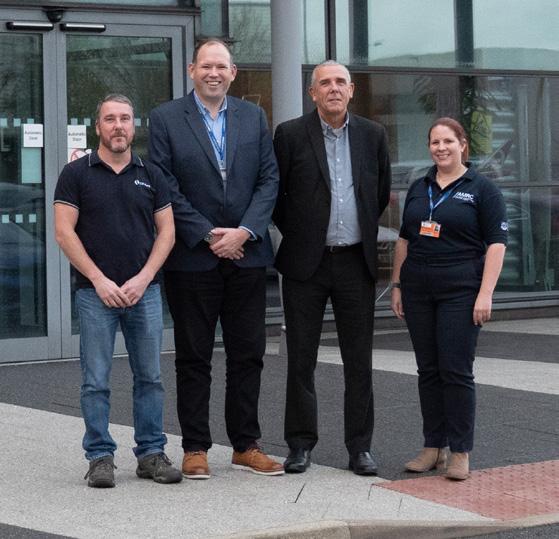
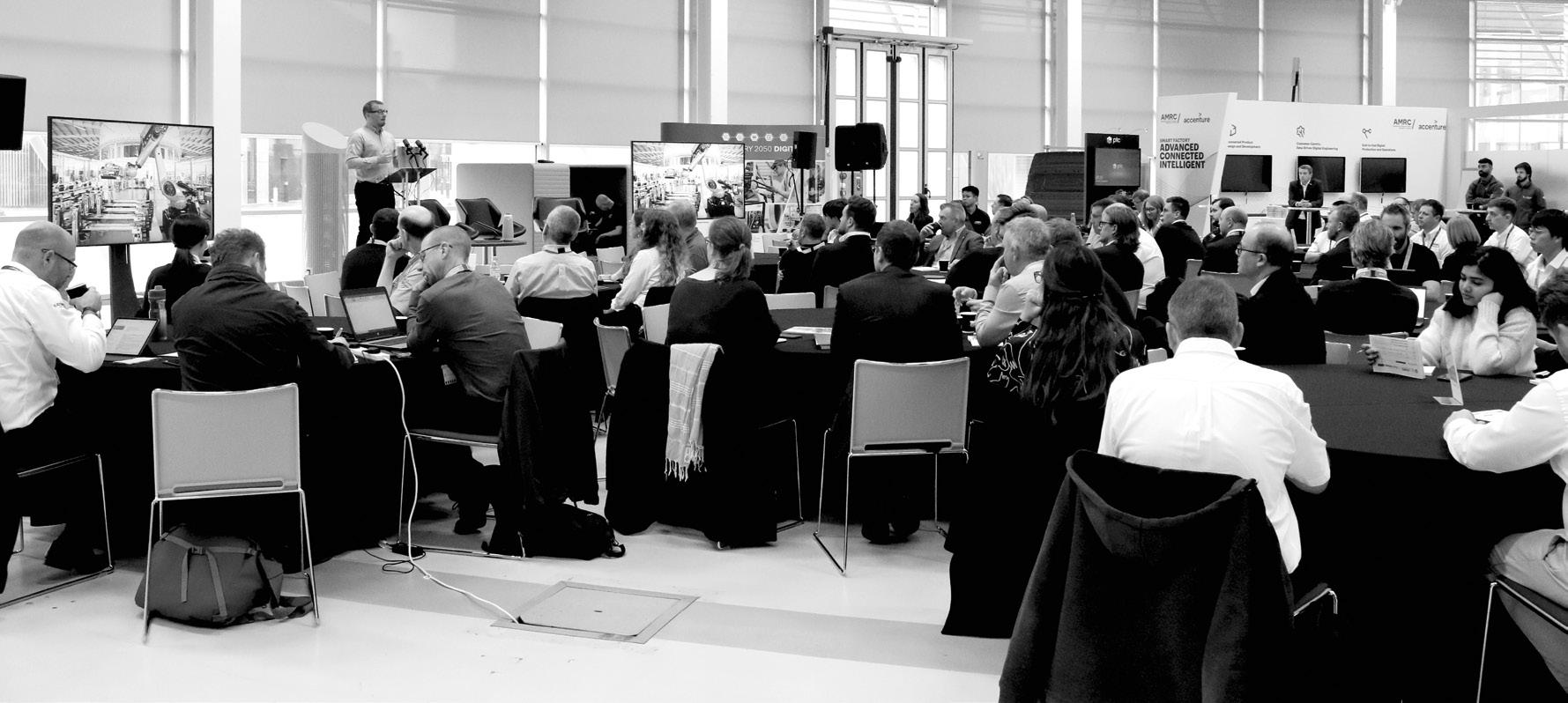
It was great to be back on the shopfloor at our flagship Factory 2050, which provided a fitting backdrop for our partners’ conference, and gave us the opportunity to really showcase the research and innovation that we have been busy working away on throughout the year.
As our CEO, Steve Foxley, said when opening the two-day conference, this decade is critical and manufacturing will play a hugely important role during the next eight years if industry is to be ready for net zero.
There was a fantastic breadth of technical presentations that really showed the expanse of capabilities that we hold here at the AMRC to help manufacturing deliver, from high-value design, right through to in-service support.
A handful of these innovations can be seen on these pages: from real-time tool prediction using artificial intelligence for more sustainable processes; to filament winding for high quality manufacture of complex but lightweight cabin air inlets, and improving aerospace buy-to-fly ratio with Wire Arc Additive Manufacturing technology.
As we develop the AMRC strategy further towards 2030, the key themes of sustainability, digitalisation, future propulsion and supply chain resilience will be seen in the majority of the research that we are doing.
We are excited to continue working in collaboration with our research partners and seeing the value that the AMRC collaborative partnership brings; events like this help us to shine a deserving light on some of the innovations and impact that is helping create a tomorrow, done better.
will aid in post-production data analysis to determine when and why problems are arising, thus simplifying mould manufacture measurement methods and ultimately improving mould quality. What’s next? Following interest from industry partners, there is an ambition to launch a project to develop a novel weighing sensor with incorporated part tracking, to explore the feasibility of the concept with respect to the existing products in the market.
The project focuses on using filament winding as a highly automated, inexpensive route for high quality manufacture of the cabin air inlet component at high rates.
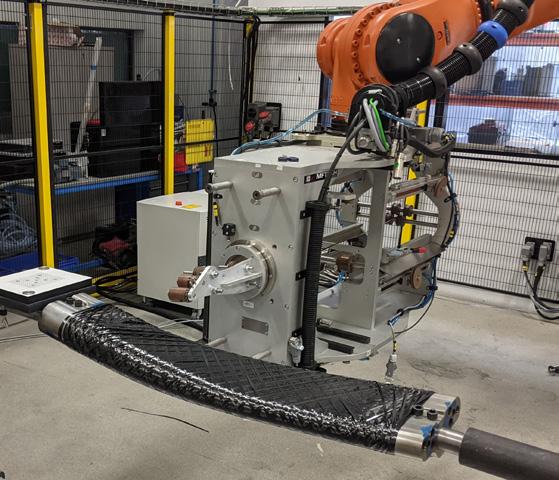
A filament-wound aircraft cabin air inlet supports increased aircraft electrification and efficiency with lower contaminants ingress, operational costs, fuel consumption and emissions, thus providing health benefits and helping achieve net zero goals. In an AMRC first, the project generated and analysed a Finite Element (FE) model from as-manufactured filament wound fibre deposition scans. What’s next? AMRC experts are looking to wind further complex geometry components, while developing new programming software specifically for this and other custom functions for ultimate lightweighting and sustainability. Work is being done to efficiently incorporate anti-icing and structural health monitoring capability into the wound inlet structure and other applicable components.
Measurement techniques for ceramic mould manufacturing have not changed for decades and rely on operators taking manual measurements, introducing error and interrupting production.
AMRC experts are looking into alternative on-line measurement methods with an aim to provide an instant feedback loop to operators - alarming them when a process or part is out of specification. This
By Javier Dominguez-CaballeroThe project, currently in its second year of development, looks at generating a knowledge base for a real-time tool life prediction framework that uses artificial intelligence (AI).
This framework will provide real-time predictions of tool wear and remaining useful life using deep learning, to protect the process against any damage arising from tool failure, making the process more sustainable. Initial results show that the framework, which has the AMRC-developed auto tool wear camera system integrated in it, works with good accuracy.
What’s next? The next phase looks to further develop the AI-based framework using more relevant machining strategies, with the objective to demonstrate a realtime digital twin in an industry-relevant component; whilst exploring the possibility of closing the loop by providing feedback control to the machine for improving tool life.
The AMRC’s Manufacturing Intelligence team (part of the Integrated Manufacturing Group), undertook a survey within AMRC’s aerospace industry partners which emphasised that companies struggle with quantifying the return on their sustainability investments and necessitate a standardised methodology to aid decision-making and quantify improvements against sustainability and profitability.
Following the survey analysis, AMRC experts developed a framework for comparing alternative scenarios, with focus on aerospace manufacturing processes, encompassing all the requirements that should be evaluated to assess sustainability (e.g. cost, energy, carbon footprint and waste reduction).
What’s next? The developed framework, an integration of a Trade Study comparison tool and a Discrete Event Simulation (DES) model, will be applied to relevant case studies and projects to help ensure that the aerospace sector remains profitable whilst fulfilling environmental and societal obligations. The project has sparked discussion and increased interest within the industry.
 By James Whincup
By James Whincup
The project used a near-net aerospace structural component to demonstrate how the Wire Arc Additive Manufacturing (WAAM) technology can be implemented to reduce the buy-to-fly (BTF) ratio, producing components more sustainable. Realising an 80% reduction in swarf produced and 35% reduction in material required, compared to traditional manufacturing methods.
So far, the project has developed an endto-end workflow during which different deposition and machining strategies were trialled to produce a high-quality demonstrator component. This project is a first step to demonstrate the potential for the industrialisation of WAAM technology and highlights material saving with machining AM demo components.
What’s next? Work is being done to develop aero-components using WAAM (DATUM) in early stages, alongside material characterisation, cost and product life cycle analysis and model-based AM workflow.
Adaptive machining expertise from the University of Sheffield AMRC has helped Rolls-Royce deliver on one of its most important research programmes to date - the world’s largest next generation aero engine demonstrator designed to support sustainable air travel.
The new Rolls-Royce UltraFan® demonstrator engine, promises to transform flight and set new benchmarks in efficiency, environmental performance and precision engineering - offering a 25% fuel efficient improvement compared with the first-generation Trent engines. The demonstrator was completed at the company’s Derby facility in December 2022, prior to testing and its first run on 100% sustainable aviation fuel (SAF).
UltraFan® required an entirely new and scalable engine architecture, one that integrated around a power gearbox. Such innovation brought with it significant mechanical and manufacturing challenges which had to be overcome in order to turn blue-sky thinking into reality.
The AMRC, a member of the High Value Manufacturing (HVM) Catapult network of research centres, has been critical in helping solve some of these manufacturing challenges, working collaboratively as part of an Integrated Project Team (IPT) to deliver the design and method of manufacture of components, alongside Rolls-Royce and fellow HVM Catapult members the National Composite Centre (NCC) and the Advanced Forming Research Centre (AFRC).
For the AMRC’s part in the £9.9m ATI and UKRI-funded manufacturing research project, technical fellow
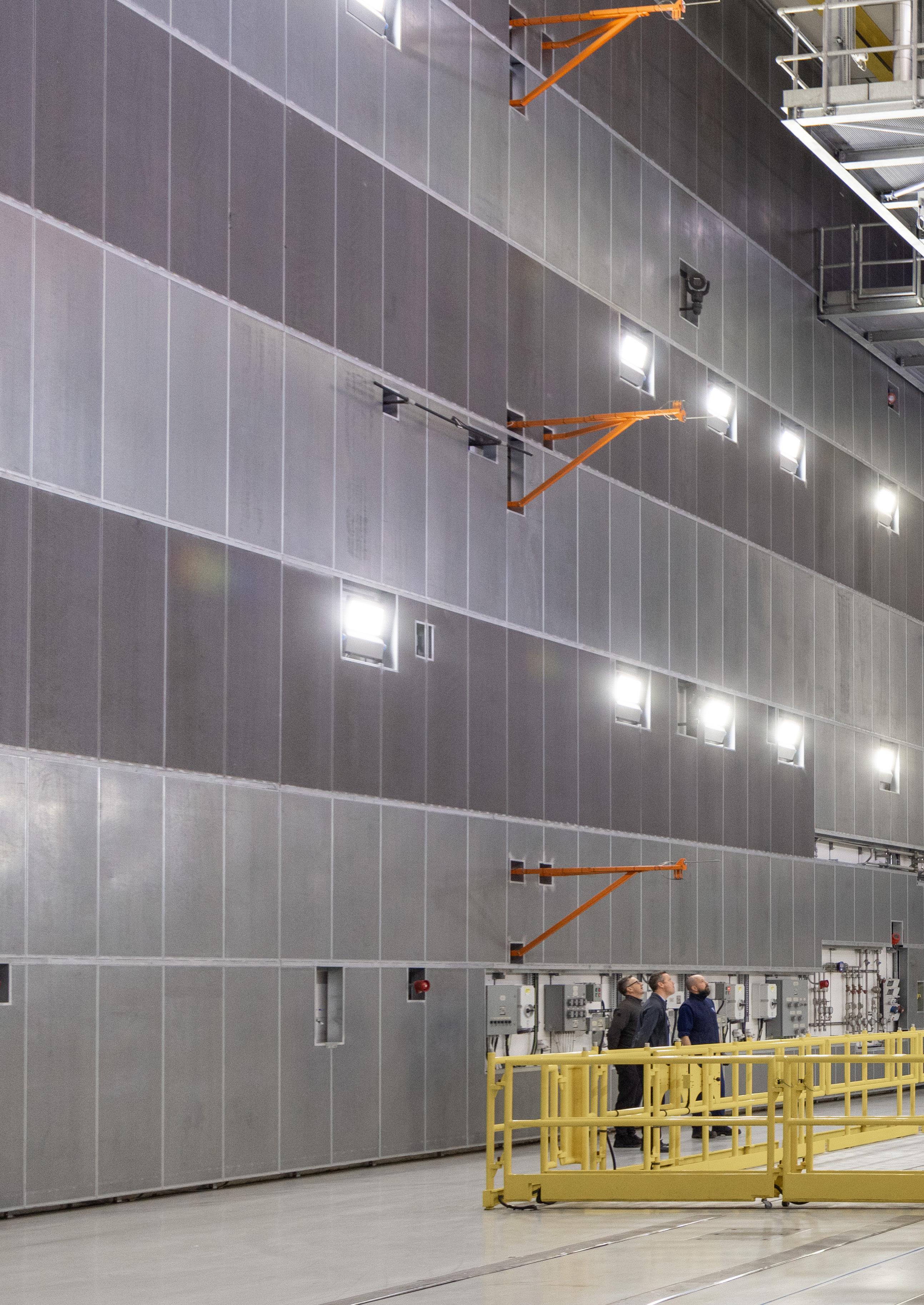
Tom McCready, manufacturing engineer Rob Gibson, and project engineer Alex Mackie, were tasked with developing a method of manufacture for a new style of outlet guide vane (OGV), a challenging component in the UltraFan® which is located behind the rotating fan and guides the working air efficiently into the rest of the engine.
Manufacturing engineer Rob Gibson explained how the UltraFan® OGV is designed to be significantly larger and carry more loading compared with an OGV on the Rolls-Royce Trent XWB engine. To reduce weight, a new ‘pocket design’ super plastic formed (SPF) process was developed to form the new style of OGVs. However, because each OGV on the

UltraFan® is unique due to variances in the forming process, Rob said each part must first be measured and the machining process then adapted to each individual OGV.
He said: “The AMRC was asked to develop a method of manufacture for the new style OGVs to account for forming variance and varying stagger angles, but
also explore ‘one-size-fits-all’ workholding. “Currently with Trent engine OGVs, you would have multiple fixtures and machines to machine the different features and camber variants. By utilising and developing an adaptive machining strategy, using on-machine inspection and a novel fixture solution, the AMRC was able to investigate the viability of such practice on the large UltraFan® OGV demo parts and meet the machining tolerances and challenges that were set by the Integrated Project Team.
“While there were still significant challenges identified in the estimated cost to manufacture the large, new style UltraFan®OGVs, the method of manufacture showed it was possible to reduce the material wastage and enable machining the pocket design vanes, from forming to assembly.”

Rob added: “The value delivered was in showing a method of manufacture, which could be done within the targets and tolerances given, but also that an estimated cost could be made, and this was used by Rolls-Royce to drive the OGV design revision for the UltraFan® engine.” With flight passenger numbers expected to increase to 5.6 billion - and with tighter and tougher environmental targetsRolls-Royce says UltraFan® will ‘redefine the world of jet engines’, offering a step change in large gas turbine sustainability that could save 25% fuel compared with its first-generation Trent engines; and the efficiency of UltraFan® will help industry transition to more sustainable aviation fuels.
UltraFan® is an ultra-high bypass ratio geared engine design developed to meet the fuel-efficiency, emissions/noisereduction and economic challenges facing the civil aerospace industry and is a key element of the Rolls-Royce net zero strategy.
In terms of the ‘big picture’ and future of aviation, Rob said the demonstration of technologies such as the quick-make, ‘all-in-one’ floating workholding fixture, adaptive machining and complex machining operations for the OGV, will go towards building confidence that they are viable for future components and materials that are near-net and complex in design,
which is an expectation for next generation aero-engine architecture. He added: “The project highlighted key challenges and, while showing we can engineer and rise to the challenge, it could be better to revisit and iterate the OGV design, so the manufacture is more simple and therefore more efficient and economical from the outset, rather than try
The UltraFan® demonstrator is the world’s largest engine demonstrator with a fan diameter of 140 inches. A London tube train could run through a circle the size of the engine’s fan case.
It is approximately one square metre but can produce more than 50 MW - that’s enough to power 500 family cars.
The largest and smartest indoor aerospace testbed in the world - with an internal area of 7,500 square metres, it is larger than a football pitch.
“The method of manufacture showed it was possible to reduce the material wastage and enable machining the pocket design vanes, from forming to assembly.”
Rob Gibson, subtractive implementation technical lead at the AMRC.
to correct any issues at a later stage.”
Rob said the collaborative spirit of the project had been a real highlight, with industry and academia coming together and working to deliver a successful project ‘building strong bonds for future work and sharing knowledge and up-skilling’, to benefit all stakeholders.
That collaborative spirit also saw the AMRC work closely with tier two partner MetLase, a joint venture between Rolls-Royce and Unipart that is based close to the research centre on the Advanced Manufacturing Park in Rotherham.

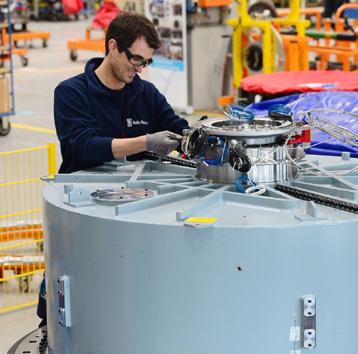
The AMRC supported MetLase on its design of a quick-make, ‘one-size-fits-all’ fixture for the UltraFan® OGV, to meet the requirements of the machining and inspection operations.
Rob said: “MetLase designed and fabricated the fixtures and provided support to ensure they delivered and worked, as designed for machining trials at the AMRC. They listened to both the AMRC and Rolls-Royce on how to make their fixture suitable for machining and were engaged throughout.
“The ‘one-size-fits-all’ workholding strategy would see all machining operations for all UltraFan® OGV variants performed on a single fixture. This has the potential benefit of reducing the footprint and number of set-up and machining stations for manufacturing - reducing overall manufacture floor space, transfer and down-time.
“The positive for MetLase is that it provides them with knowledge and upskill in designing fixtures for machining, making them more capable and competitive.”
Data collection was key to driving the machining strategy and operations, says Rob.

“The parts were probed whilst on the CNC machine to determine the forming variation and effects of the machining. This data drove the machining strategy and operations. The parts were scanned before and after machining. This was additional data to track the form change after machining, which helps to drive the forming process so residual and cutting stresses are mitigated.
“The project showed how high-quality data collection could drive the manufacturing process to report back to the operator if the adaptive machining was within boundaries.”
UltraFan® is the world’s largest aero engine technology demonstrator, providing both a new engine design and a suite of technologies that Rolls-Royce says can support sustainable air travel for decades to come.
It will be 25 per cent more fuel efficient than the original Trent 700 and is a key element of the Rolls-Royce sustainability strategy, as part of its commitment to continue to improve gas turbine performance and efficiency.
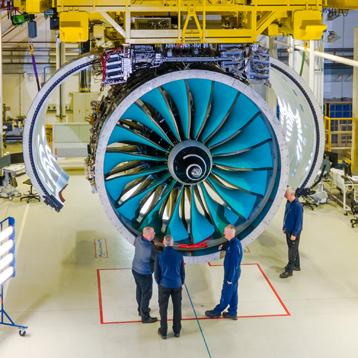
UltraFan® features a new architecture and lightweight composite materials as well as the world’s most powerful aerospace gearbox. It also offers a 40% improvement in NOx and 35% lower noise. In addition, it will be compatible with 100% sustainable aviation fuels. Rolls-Royce is also exploring hydrogen and hybrid electric as alternative forms of power. There is also potential to transfer technologies from UltraFan® to current in-service engines to provide even greater fuel efficiency and reductions in emissions.
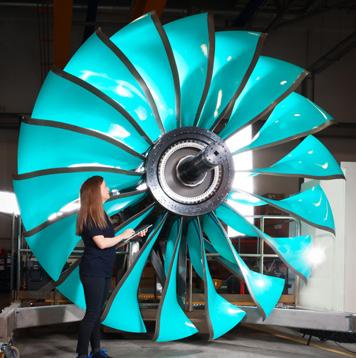
When it comes to technology and architecture, UltraFan® features a new engine core architecture to deliver maximum fuel burn efficiency and reduce emissions and a CTi Fan System with carbon/titanium fan blades and a composite casing.
It is constructed using advanced manufacturing and materials and technologies such as ALM to save on waste and allow for more intricate designs and CMC materials to withstand higher temperatures. UltraFan® also features a geared design which will deliver efficient power for the high thrust, high bypass ratio engines of the future.
The engine demonstrator (UF001) is now preparing for testing at the new engine test facility, Testbed 80, in Derby UK and the first run will be on 100 per cent Sustainable Aviation Fuel.
UltraFan® is due to be available to the market in the 2030s, with the timing determined by airframer requirements and market demand.
The University of Sheffield Advanced Manufacturing Research Centre (AMRC) has collaborated with Archer Technicoat Limited (ATL), TISICS Metal Composites and Cygnet Texkimp to deliver a project on ‘Continuous Interface Coating for Silicon Carbide (SiC) composites’ or CICSiC for short.
The project focused on the manufacture routes for silicon carbide-based Ceramic Matrix Composites (CMCs) - a material of particular interest for high temperature applications of up to 2,000 degrees Celsius in sectors such as aerospace, space and nuclear. The delivery of the project builds
on the AMRC’s reputation as one of the leading centres nationally for research in the manufacture of these materials.
The interface between the fibre reinforcement and the matrix is a critical component of CMCs. The project aimed to develop equipment and processing know-how for uniform, continuous coating of interfaces on SiC fibres, such that the mechanical properties of SiC-based CMCs can be more closely specified to enhance their aerospace applications.

This enables the development of more efficient engines, offering significantly lower weight, lower cooling requirements
and lower aircraft emissions - resulting in a reduced impact on the environment.
“SiC-based ceramic matrix composites are a promising material for many extreme environment applications including aero engines,” says Ryan Skillett, technical manager at ATL. “The CICSiC project kick-started the development of a new method for manufacturing these high value materials, aiming to simultaneously bring down costs whilst improving performance and reliability.”
The project aimed to develop a new reelto-reel coating technology to replace the current batch coating method to apply
Lower emissions and increased aircraft performance are benefits of a novel prototype machine developed by an industrial consortium that includes the AMRC, designed to improve the coating technology for ceramic matrix composites.Nicalon fibres (circled) used as binder yarns in an 8-layer orthogonal 3D woven textile made up of 12k PAN fibres.
interphase coatings to CMCs. In the batch coating method, a preform is made from uncoated fibre which is treated in one step, making it difficult to ensure an even coverage of all areas of the preform with equal precision. The new method uses a reel-to-reel process to apply the interphase coating. Material is wound from its original spool onto a new spool with the interphase being applied in-between. This ensures a uniform coating. As the material is still on a spool, it can easily be used in fibre processing technologies. This allows for shapes with increased complexity to be formed with a uniform interphase coating. Ryan says the results of the project have drawn international interest from specialists. He added: “The project worked towards the creation of a continuous fibre coating system to work in harmony with the existing batch-based technology, and in doing so, look to take on some of the major barriers to market for the product. The results of this project have drawn international interest from specialists in the material, leading us to believe it has a very bright future.”
The AMRC’s role in the project focused on the industrial scale processing of SiC fibres to produce preforms with increased complexity. The ability to process the fibre is key to realising the potential of this material. Utilising SiC fibres in processing technologies such as weaving and Tailored Fibre Placement (TFP) is important for building confidence in the handling of these materials so that they can be adopted into industry, and understanding the current processing limits.

The work on handling fibres was performed on as-purchased SiC and on SiC provided by ATL that had undergone the coating procedure in order to understand the difference in processing requirements, limitations and the quality of the output.
“Silicon carbide composites (SiC-SiC) are of interest to many industry sectors looking at high temperature applications,” said Steffan Lea, a technical fellow in the AMRC’s composites team. “The ability to produce more complex preforms from continuous silicon carbide fibre will enable new designs and applications for this high performance ceramic matrix composite (CMC) material.”
Steffan says the AMRC’s understanding of how to process SiC fibres has developed. He added: “During the CICSiC project, the AMRC has gained familiarity and knowledge on how to process SiC fibres on industrial-scale machines. Our knowledge on how to process SiC fibres on weaving
looms to produce 3D woven preforms enables the production of unitised preforms with added complexity. Using the Nicalon on Tailored Fibre Placement (TFP) allows us to make efficient use of the material, only placing it where it is required and controlling the path of the fibre to make best use of its properties.”
Kevin Morris, National Aerospace Technology Exploitation Programme (NATEP) technology manager at Farnborough Aerospace Consortium, said the project has proved to be a ‘very successful’ collaboration, and with the help of funding from NATEP has delivered ‘a winning project’.
He added: “The CICSiC project itself was able to develop the innovation and methods associated with the continuous coating of silicon carbide fibres, and demonstrated how issues could be overcome paving the way for more efficient propulsion systems for future aircraft, fulfilling the aims of the NATEP programme.”
Ryan commended the AMRC’s contribution to the project, adding: “The AMRC provided key insight and experience with handling the fibres, both in their coated and uncoated forms. Without its input, the CICSiC project would not have been as successful and the next generation equipment would not have gained as much interest.”
Andy Whitham, director of process development at Cygnet Texkimp Ltd said: “Working on this project has allowed us to understand the challenges associated
with handling very delicate ceramic fibres. These are unusual in some of their characteristics, so having first hand experience of the difficulties involved in their use is invaluable. Beyond that, the opportunity to work with new partners from outside Cygnet Texkimp’s main sectors, always provides a different view on the machinery we might supply for a given application.”
The CICSiC project showcases the excellent work done by the AMRC’s composites team and the spread of its activities in the SiC- SiC composites area. It promotes and accelerates the development and manufacture of advanced materials technology and high strength, high temperature materials such as ceramic matrix composites within the UK supply chain.
CICSiC was funded by the National Aerospace Technology Exploitation Programme (NATEP), a £15m programme to develop 60 aerospace technologies in the UK aerospace supply chain. Funded by the Aerospace Technology Institute and managed by ADS, it is aimed at small and mediumsized enterprises (SMEs) to develop innovative technologies to enhance their capabilities and increase their ability to win new business.
We can learn a lot for Sir Titus Salt, says Dr Andy Bell, sustainability theme lead for the AMRC.

On the outskirts of Bradford on the river Aire, sits Saltaire, a UNESCO world heritage site that created a vision for sustainable manufacturing when a textile mill was first opened there 170 years ago this year. It was a vision by Sir Titus Salt that would see the introduction of some of the earliest humanitarian approaches to manufacturing at a time when 16-hour days, unsanitary housing and factories, poor standards of education for the workforce, and the disruption to livelihoods by steam were omnipresent.

I have long held a fascination with Sir Titus Salt, the village of Saltaire named after him and his Salts Mill ever since I visited as a child in the mid-1990s. And now, looking back and reminding myself of the Saltaire story, I see the parity between the work that the AMRC is doing today around sustainable manufacturing and the role that Sir Titus Salt and his peers played in the middle of the 18th Century.

Pioneers like Salt recognised that sustainability was more than decarbonising a few machines and
processes. They extended their reach into ensuring there was running water, sanitation, education, green spaces, and healthcare for all mill workers. Alongside this welfare-oriented approach, Salt endeavoured to reduce the pollution generated both within and external to Salts Mill, recognising the link between localised pollution, health, and productivity long before climate change was even considered. Surely this is what it means to be sustainable? We define sustainability in a myriad of ways, and often see it
manipulated to suggest that our actions are sustainable via green-washing. The reality, for me personally, is that to be sustainable we must do no harm and leave no trace. In other words, if we take a product at the end of its useful life, then it should have left behind no negative evidence that it ever existed, no net positive carbon emission, no waste and no detriment to the health of those who created or operated it.
I left university more than 20 years ago with the belief that we could engineer our way out of most problems, and had
little to no clue as to the damage humanity was really having on the environment. My belief that engineering was the cure was quickly challenged when I was made redundant in 2003. I began to question why viable manufacturing businesses would close their doors rather than diversify their portfolio. I found myself exploring the social sciences for an answer.

This exploration of human behaviour quickly became a passion, and I eventually began applying it to developing approaches to creative problem solving for the AMRC’s design and prototyping team. It was during a strategic review for the team about four years ago that sustainability was identified as potentially being a core pillar of the team’s future. I recognised that sustainability was a socio-technical problem. In other words, a problem that required both human behaviour and technology to work in tandem to create a solution.
I felt I could add something to this space, pulling on my varied background in new product development, manufacturing and creativity to work towards creating a solution. The sustainability problem allows me to operate in an unusual space, somewhere between the physical and social sciences. A place where a solution often requires a change in technology, for example battery electric vehicles, in tandem with a change in behaviour, for long duration refuelling. The result of this may be a change in the design of service areas to support work or recreation on the move, and can be evidenced by the
proliferation of battery charging stations at shopping centres.
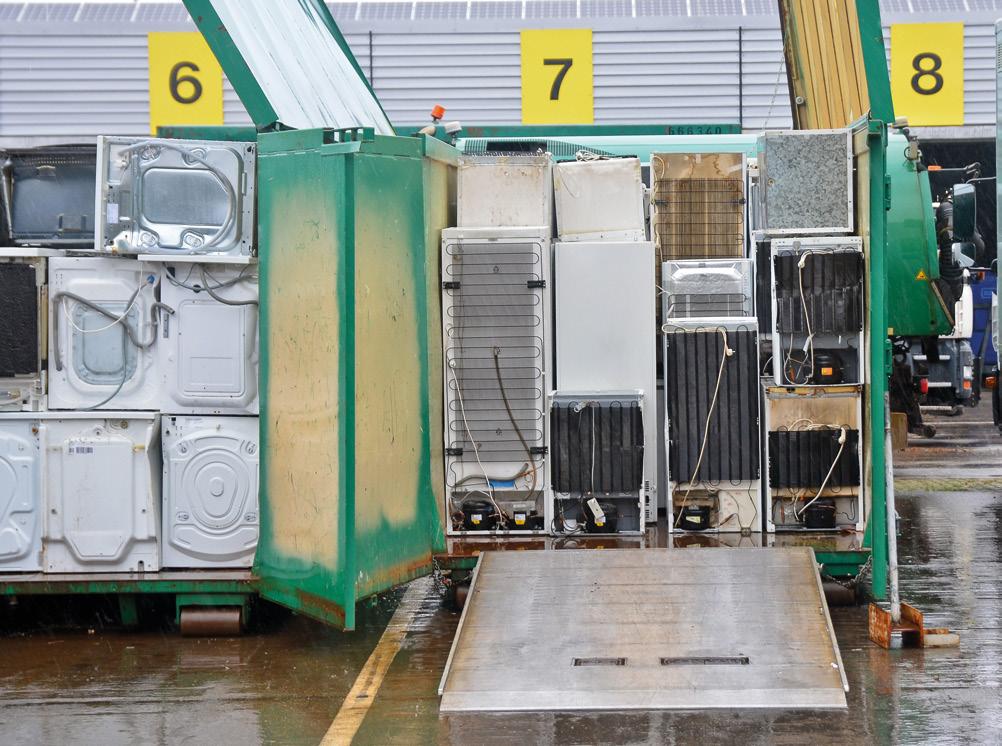

The sustainability space is, however, also a moral obligation for me. It poses significant questions about the legacy that this generation will leave the next and goes beyond the scientific challenges we are by now all familiar with. As a byproduct, and in my view secondary to the moral obligation, it is well recognised that sustainable operations, circular economies, and a gentler touch on the planet are primed to generate a huge business opportunity for first movers. Leading to the birth of whole new industries to support
the transition.
We must also start to question how our impact is being felt. Not just by the industries that we influence, but also by communities more widely. To help the AMRC achieve this, we are being supported by thought leaders in the wider academic community to understand our place in the sustainability agenda. This means undertaking a full and fair assessment of the work that we do and beginning the complex journey of understanding how what we do moves the dial toward real carbon neutrality and a sustainable future. More practically, the objectives of the
AMRC are to explore those technologies that enable sustainability to become a reality, such as simplified energy assessments of a given manufacturing process and expand on their capabilities so that they become viable industrial approaches and exploit their use in the real world. This is what the AMRC has done so successfully for more than 20 years in the productivity space. We only need to change the lens to one of sustainability to be successful.

At the same time, the AMRC needs to become an exemplar in sustainable operations, decarbonising our facilities and creating the blueprints for the future of UK and global manufacturing. We are now asking fundamental questions about the reach of an organisation in achieving this. Do we recreate the humanitarian approach of Sir Titus Salt, integrating manufacturing facilities into the community as hubs for more than jobs? Or do we call a halt when we have a net zero facility? We already have outreach programmes with local schools to promote the STEM subjects, how much further should we go?
We are, in truth, at the very beginning of our sustainability journey. The AMRC is working with some of the best minds in the field to define our role in this space. Leaders like Mike Berners-Lee, a professor at Lancashire University, English researcher and writes about carbon footprinting - also owns organisation Small World Consulting, which pushes for systemic change in response to the world’s climate and ecological emergency, has helped us create a global framework assessment for all our projects. This allows us to estimate not just whether a project is fit for net zero, but also what impact our projects may have on the wider sustainability agenda - as well as
helping at a local scale for the assessment and optimisation of a given manufacturing process with our teams across the AMRC. Sir Titus Salt didn’t have our capability to measure, monitor, and understand the influence and impact of sustainability. Salt couldn’t measure the energy usage of each aspect of his process, or prove the benefit of building health centres and libraries beyond the anecdotal. Yet, Sir Titus Salt fundamentally changed the way we think about the role of the manufacturing facility in society. Imagine what could have been achieved by Salt today, given 170 years of technological development and understanding.
The reality, for me personally, is that to be sustainable we must do no harm and leave no trace
SolarBotanic Trees Ltd, a London-based renewable energy startup, is working with the AMRC to develop a field prototype for the integrated, scalable and sustainable power generation system. The project aims to build an integrated battery power storage system using the solar trees in locations where a renewable but ‘aesthetically attractive’ solution is required, such as for urban residential and commercial settings.
The ‘tree’, which has a dome made up of nano photovoltaic (PV) ‘leaves’, can harness enough solar energy to power individual homes, and charge electric vehicles; while its sleek aesthetic means it is not only easy on the eye but on the environment too - providing a clean and green energy solution to accelerate the UK’s net zero journey.
The AMRC, part of the High Value Manufacturing (HVM) Catapult network of research centres, is providing the product development and design support to help build a functional prototype for testing.
John Spencer, senior project manager at the AMRC said: “We are delighted to be working with the fantastic team at SolarBotanic Trees on the development of its energy-generating solar tree. The business has a great product which will play an important role in developing the infrastructure necessary to support the shift to zero-emission electric vehicles (EVs), a core part of the UK government’s net zero strategy.
“The AMRC will provide design and prototyping support to advance the
product through a rapid development cycle, enabling the company to launch the first solar tree, fulfil its pre-orders, and gain traction in the EV charging market. SolarBotanic Trees’ vision to create carbon-reducing technologies aligns with the AMRC’s drive to support the high-value manufacturing sector on the journey to net zero.’’

Chris Shelley, CEO of SolarBotanic Trees, said: “With the AMRC bringing its design and prototyping expertise to the table it will help us accelerate commercialisation. The team at the AMRC is a great partner for SolarBotanic Trees to deliver the prototype at speed using its world-class facilities and talent which will enable us to rapidly move to commercial production in the near future, starting with our launch order for
200 trees for RAW Charging Group, a high growth UK and EU focussed EV charging service provider.”
Other project partners include the Manufacturing Technology Centre in Coventry (MTC) and the Advanced Forming Research Centre in Scotland, both part of the HVM Catapult, along with Brunel University in London and Unipart Technologies Group (UTG) part of Unipart Group.
The latest project is rooted in a five-day design assist previously undertaken for SolarBotanic Trees, which saw the AMRC deliver a range of design concepts for the trunk, branch and petal structure of the solar tree, as well as investigating a range of monitoring and sensing methods to test, assess and select various PV cell options.
The first commercial prototype of an innovative solar ‘tree’ capable of powering homes and charging electric vehicles is being developed by experts at the University of Sheffield Advanced Manufacturing Research Centre (AMRC).Easy on the eye and environment: This artist’s impression shows how the solar ‘tree’ would look in an urban space. Image credit: SolarBotanic Trees
The results of a new study to test the viability of hydrogen as a climate-friendly fuel for steelmakers are expected soon, having been launched last year by energy provider E.ON, leading a consortium of academics and industry partners, including the University of Sheffield Advanced Manufacturing Research Centre (AMRC).
The initial feasibility study, announced last November, set out to explore the potential of generating hydrogen from biomass - a renewable energy source, which can be used as an alternative to fossil fuels in South Yorkshire’s energy intensive steel industry, supporting cleaner energy and a greener economy. It also investigated the supply chain needed to help industrial customers switch away from natural gas as a fuel - focusing on hydrogen production, distribution and end use in industrial steel production.
E.ON, the University of Sheffield, Forgemasters and Forged Solutions, alongside Chesterfield Special Cylinders and Glass Futures are also part of the project. It has been funded by government through its Net Zero Innovation Portfolio (NZIP) based at E.ON’s Blackburn Meadows renewable energy park in Sheffield.
Stuart Dawson, the AMRC’s chief engineer for hydrogen, said the AMRC is committed to supporting the decarbonisation of industry processes to deliver the outcome we all want – a decarbonised, competitive and resilient UK manufacturing sector.
“Using our industrial contacts and those in the wider R&D ecosystem, the AMRC helped to bring key capabilities into the consortium such as Glass Futures and the University’s Translational Energy Research Centre (TERC),” Stuart added.
“The University’s main contribution to the project was combustion modelling to understand how fuel switching from natural gas to hydrogen affects a furnace’s thermal performance and emissions. In addition to the Translational Energy
Research Centre’s (TERC) modelling capability, the AMRC has other tools in its decarbonisation tool kit, such as emissions auditing, along with the use of digitalisation and data analytics to help reduce energy consumption.”
Michael Lewis, E.ON UK CEO, said: “Hydrogen will play a significant role in our energy future, mainly powering energy-intensive industries and longdistance transport. It sits alongside the drive for heat pumps meeting domestic heating needs and a greater role for district energy schemes in urban areas.
“Our Blackburn Meadows plant is the perfect example of a range of technologies coming together to provide a solution for an entire city and generating green hydrogen for Sheffield’s

world-renowned steelmakers means an economic win for them, greater security of their energy supplies as well as better air quality for the city and accelerating Sheffield’s energy transition to net zero.”
Professor Mohamed Pourkashanian, OBE, leading on the project for the University of Sheffield, said: “To reach a hydrogen economy there will be many barriers, not least in fully understanding and investigating the technical challenges faced in switching to hydrogen as a fuel, and how it will integrate into our existing infrastructure.
“This project takes a vital step in making this technology a reality for industrial partners, and its findings will not only support the decarbonisation of the steel industry, but also has potential to bring practical and theoretical knowledge to other foundation industries.”
The study was set to run until early 2023 – and if proven to be successful, the project could progress to a technical pilot project on the Blackburn Meadows site, with future potential for expansion if the project is taken forward to a full commercial demonstration.
Aerospace giant BAE Systems has teamed up with the AMRC to drive digital innovations including data visualisation, automation and digital inspection into the maintenance of aircraft to reduce costs, improve efficiency and lower carbon emissions. Mrudula Jadhav reports.

Future Air Support was launched by BAE Systems in November 2022 at Royal Air Force (RAF) Coningsby, home to the UK’s Typhoon fleet. The University of Sheffield Advanced Manufacturing Research Centre (AMRC) has joined the project as a research partner to investigate how digital technologies - along with greener, sustainable solutions - can be used to elevate the RAF’s fleet of frontline aircraft.
Nick Sharples, BAE Systems’ head of technology capability delivery – training and support, says the partnership between the AMRC and BAE Systems builds on a long-established relationship that has produced transformational collaborations. Future Air Support vision will see the transformation of fast jet support capabilities now and for future aircraft platforms, such as Tempest.
“We have worked with the AMRC on numerous projects, from small demonstrators to full facilities like Factory 2050 in Sheffield and our Factory of the Future in our BAE Systems site at Warton,” said Nick. “That established trust gives us a strong basis. When we add to that track record, a mutual desire to explore the fast jet support domain, we have a real catalyst for collaborative work together.
“Our initial focus areas with the AMRC are data visualisation, automation and digital inspection; but technology development is at the heart of this, and any number of digital technologies can be established and accelerated.
“Working with our partners to trial new technologies and solutions for future fast jet support helps us explore new ways of delivering leading-edge capabilities and value for money for our customers, whilst

reducing environmental impact.”
Ben Morgan, AMRC’s research director, says digital technologies can unlock greater sustainability in the infrastructure of organisations like the Royal Air Force and the cutting-edge innovations being developed alongside BAE Systems will add to the suite of digital technologies available for the Future Air Support project.
He added: “The work we are doing on 5G, the innovations in sustainability we are exploring at AMRC North West, and the past achievements with the collaborative workstation, will all feed into the Future Air Support. We know the mixed reality


headsets, the 5G network and the automated inspection systems can work; it’s now about integrating it and applying it in a real-world environment.”
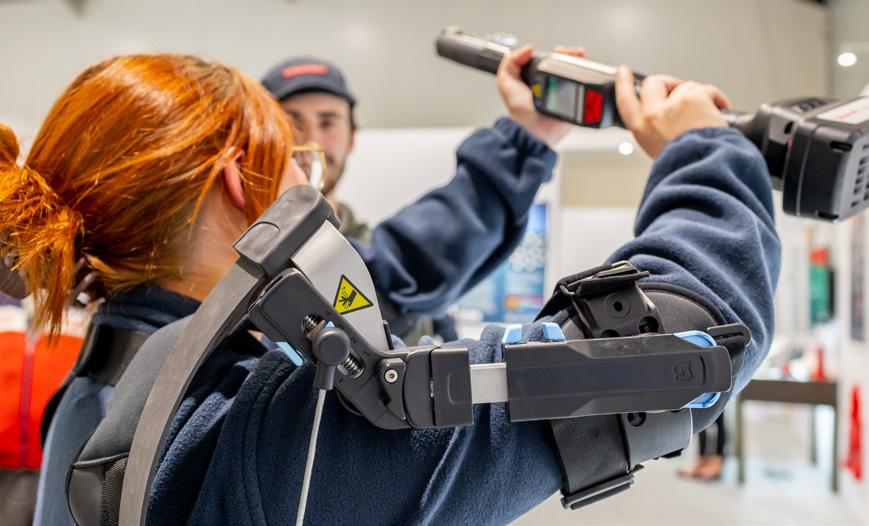
The innovations from the project will significantly reduce costs and improve the availability of front line Typhoon fighter jets and, in the future, Tempest. These technologies could be used to reduce fatigue and chance of injuries among support crews as well as improve the speed of maintenance on aircraft. Some of the programmes being trialled include: exoskeletons, autonomous cobots, augmented reality headsets and
sustainable operations.
Nick said: “We are extending the digital thread so that there is an end-to-end digital default approach, from manufacture on the factory floor to support in the operational environment. Digital technologies can create new ways of delivering leading-edge capabilities and value for money, whilst reducing our environmental impact.”
Ben explained that incorporating digital technologies ‘creates agility, fidelity and efficiency’. He said: “You could have an automated guided vehicle (AGV) pull a jet into the hangar while a drone might inspect for battle damage or bird strikes.
Then within the building there could be vision systems and photogrammetry, another AGV might inspect the undercarriage with a robotic arm and an engineer wearing an augmented reality (AR) headset would be guided through an operation.
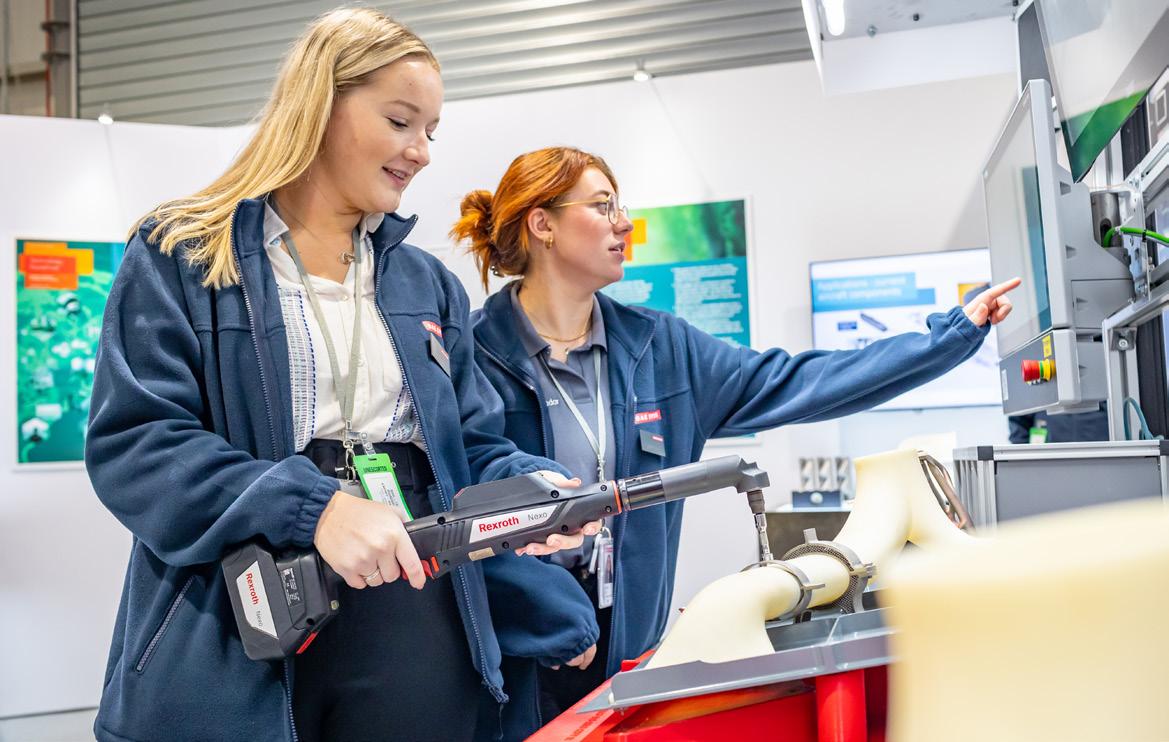
“Incorporating those digital technologies creates agility, fidelity and efficiency; the more you can digitise the maintenance, repair and overhaul (MRO) and automate the inspection processes, the better. Crucially though, the data you acquire through digitalisation will lead to greater through-life engineering, lower costs and better sustainability. If we understand the data, we understand the waste, and we can get systems working better and greener.”
The AMRC has also worked with BAE Systems to support mixed reality and geotagging technologies to build a powerful maintenance, repair and overhaul (MRO) digital twin. The Future Air Support project is the next step in that work. The partnership builds on a long-established relationship between the AMRC and BAE Systems that has produced transformational collaborations such as the robotic countersinking project, which enabled an automated production system to accurately machine holes in composite aircraft components; the development of a collaborative robot workstation fitted with a range of digital technologies, which has been introduced to BAE Systems’ Warton site in Lancashire; and the evolution of the Factory of the Future facility, an intelligent, smart factory set to increase productivity and revolutionise combat aircraft production.
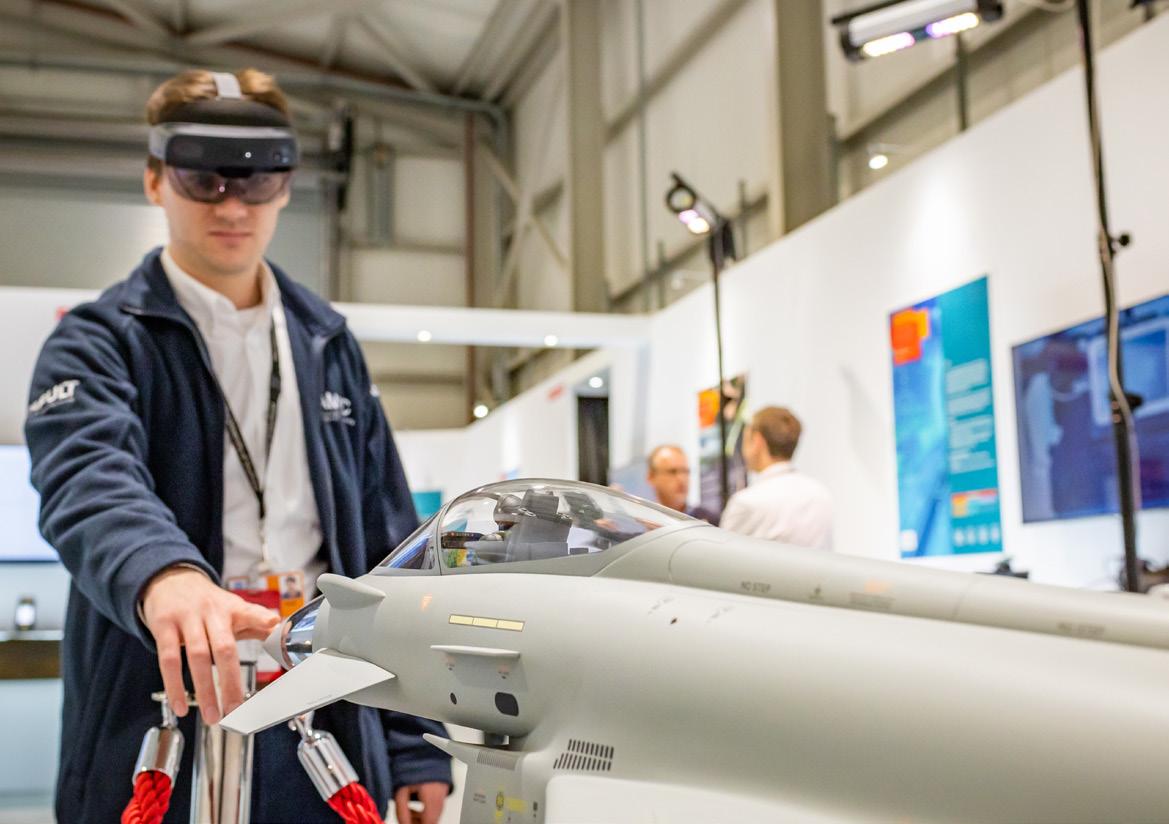
“Our initial focus areas with the AMRC are data visualisation, automation and digital inspection; but technology development is at the heart of this, and any number of digital technologies can be established and accelerated.”
Nick Sharples, BAE Systems’ head of technology capability delivery – training and support.
East Midlands Railway (EMR) is working with engineers from the University of Sheffield Advanced Manufacturing Research Centre (AMRC) to create a simulation tool that will help improve the efficiency and effectiveness of its depots.
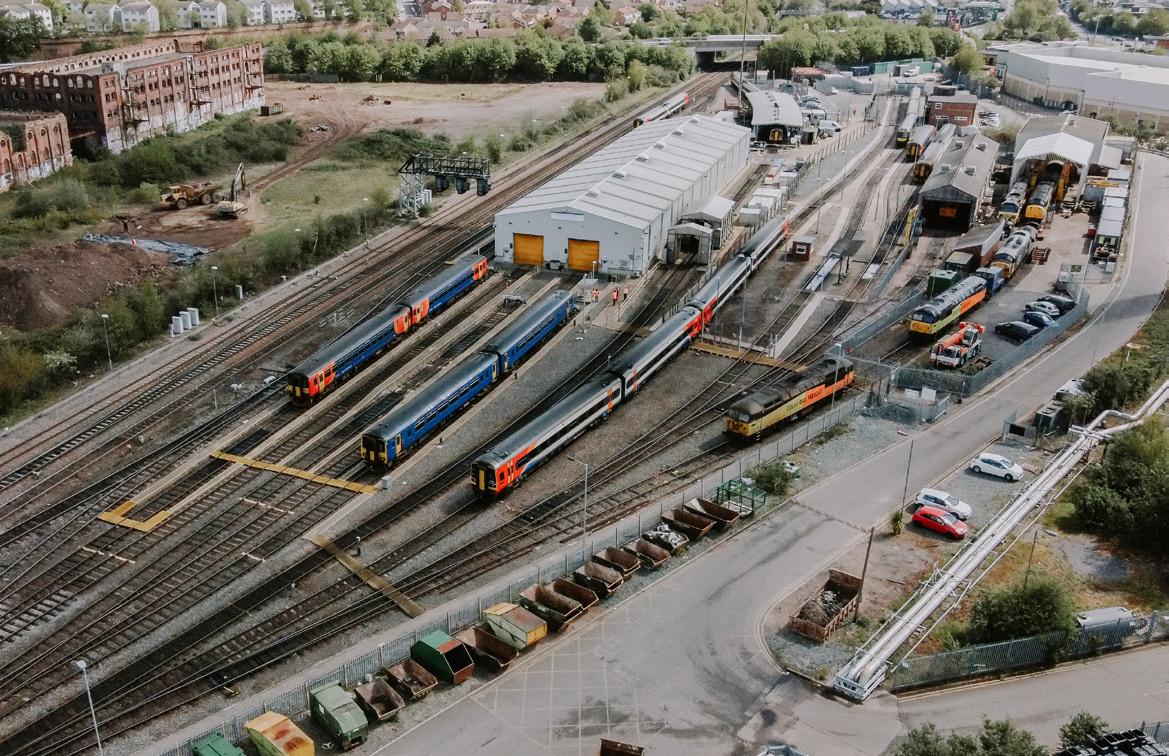
The project, made possible by the Network Rail Performance Improvement Fund, has seen AMRC engineers work closely with EMR operations staff to record the rules, processes and timings of train movements to develop a representative model of its Nottingham Eastcroft depot.
Eastcroft provides the day-to-day maintenance of the EMR Regional fleet - a very complex operation as the fleet is split into three different types of train, known as Class 156, 158 and 170s.
The tools create a virtual simulation of activities taking place on the shop floor at the depot and gives the user the power to identify capacity constraints, model scenarios and rapidly visualise the impact on performance.
They will enable EMR to plan, stress test and simulate operational scenarios in a fraction of the time it would take using conventional methods - hopefully improving train services for customers.
Richard Gardiner, AMRC senior innovation fellow and sector lead for rail, said the AMRC has relished the opportunity to work with East Midlands Railways (EMR) on a depot modelling project.
“We are collaborating to assess the application of state-of-the-art process flow simulation tools to assist the efficiency and effectiveness of rail depot operations.
“The AMRC is drawing on its manufacturing intelligence team’s significant expertise in modelling and optimising manufacturing production facilities using a range of tools. These
tools create a virtual simulation of activities taking place on the shop floor and give the user the power to identify capacity constraints, model scenarios and rapidly visualise the impact on performance.
“The model incorporates the depot and local Nottingham station roads and accommodates a range of units. It provides a virtual representation of activities in a 24-hour period and assists the current ‘beat-rate’ exercise. This model will add a dimension of scenario planning that was previously difficult and time consuming to accomplish.”
Richard added: “Since usability is a key feature of the project, a user-friendly interface is being developed that allows
users to adjust variables and model scenarios without detailed process modelling software knowledge. As a net result of all the features and components of the model, depot operations can be made more efficient with an improved unit availability and better service to the public.”
Neil Bamford, fleet director at East Midlands Railway, said: “We are always looking at ways we can embrace technology to help us run our services more effectively and are delighted to be working with the AMRC on this project.
“We hope this collaboration will result in a more detailed understanding of all the barriers that impact on running depot operations as efficiently as possible.”
The AMRC Data Cloud will open up access to world-leading machine learning and artificial intelligence capabilities for less cost to unleash new waves of innovation in industrial processes. In addition, the EyUp Data Science Academy will supply the skills and knowledge needed to get the most from these applications.
Both initiatives were launched at the ‘How Data Will Shape the Future of Manufacturing’ event at Sheffield’s Kelham Island Museum and attendees were shown how the data cloud works and discussions on how it could benefit businesses big and small.

Ryan Diver, chief engineer for digital transformation at the AMRC, said the data cloud brings cutting-edge analytics technologies to manufacturers, reducing the barrier to entry.
“Collaboration is key to future innovations in manufacturing and the data cloud will enable that,” he added. “Manufacturers have the domain knowledge, and through the EyUp Data Science Academy, we want to give them the training and tools to get the most from their data.”
David Richards MBE, chair of the AMRC Digital Meet Manufacturing Commission, added: “Manufacturers are facing difficulties caused by Brexit, Covid and war in Ukraine. The AMRC Data Cloud and EyUp Data Science Academy will help overcome these challenges and drive growth.
“It’s fitting we’re launching these initiatives at Kelham Island Museum, a testament to Sheffield’s industrial past. We believe today’s industrialists can seize an opportunity by harnessing the power of new technology.”
Professor Koen Lamberts, President and Vice-Chancellor of the University of Sheffield, said: “The data cloud will allow manufacturers to generate actionable insights from their own factories to cut energy bills, boost productivity and become more competitive.
“These tools and technologies will help accelerate the digital transformation of an important sector, and the EyUp Data Science Academy, alongside our degree programmes and apprenticeships, will ensure businesses have the future skills they need.”
WANdisco plc, the Sheffield and Silicon Valley-based live data company, and the University of Sheffield’s Advanced Manufacturing Research Centre (AMRC), built the AMRC Data Cloud, with support from Databricks and Microsoft. The infrastructure will help smaller manufacturers adopt robotics, sensors, 3D printing and augmented reality in their factories and unlock new applications. These include predictive maintenance, improved forecasting for yields, supply chain management, energy consumption and demand, automated quality testing and optimised transport and logistics. The Data Science Academy will equip manufacturers with what they need to introduce data science techniques to their factories. The accredited six-week course is being delivered by skills provider EyUp, in partnership with the AMRC and Innovate UK.
The academy is aimed at industry practitioners, with some familiarity of computer programming and looks to produce ‘bilingual’ graduates to understand data science and manufacturing. The course provides an overview of data science techniques and applicability in manufacturing environments, requirements for acquiring and using data in machine learning and experience real-world scenarios employing the AMRC Data Cloud.
UK manufacturers will be able to cut energy bills, boost productivity and become more competitive with the launch of bleeding-edge digital tools and technologies to harness the power of data science in their factories.
A £1.7m project is being delivered by Q5D Technologies in collaboration with the University of Sheffield Advanced Manufacturing Research Centre (AMRC) to accelerate the automation within the aerospace industry by using a novel robotic solution to add embedded wiring into complex aircraft components.

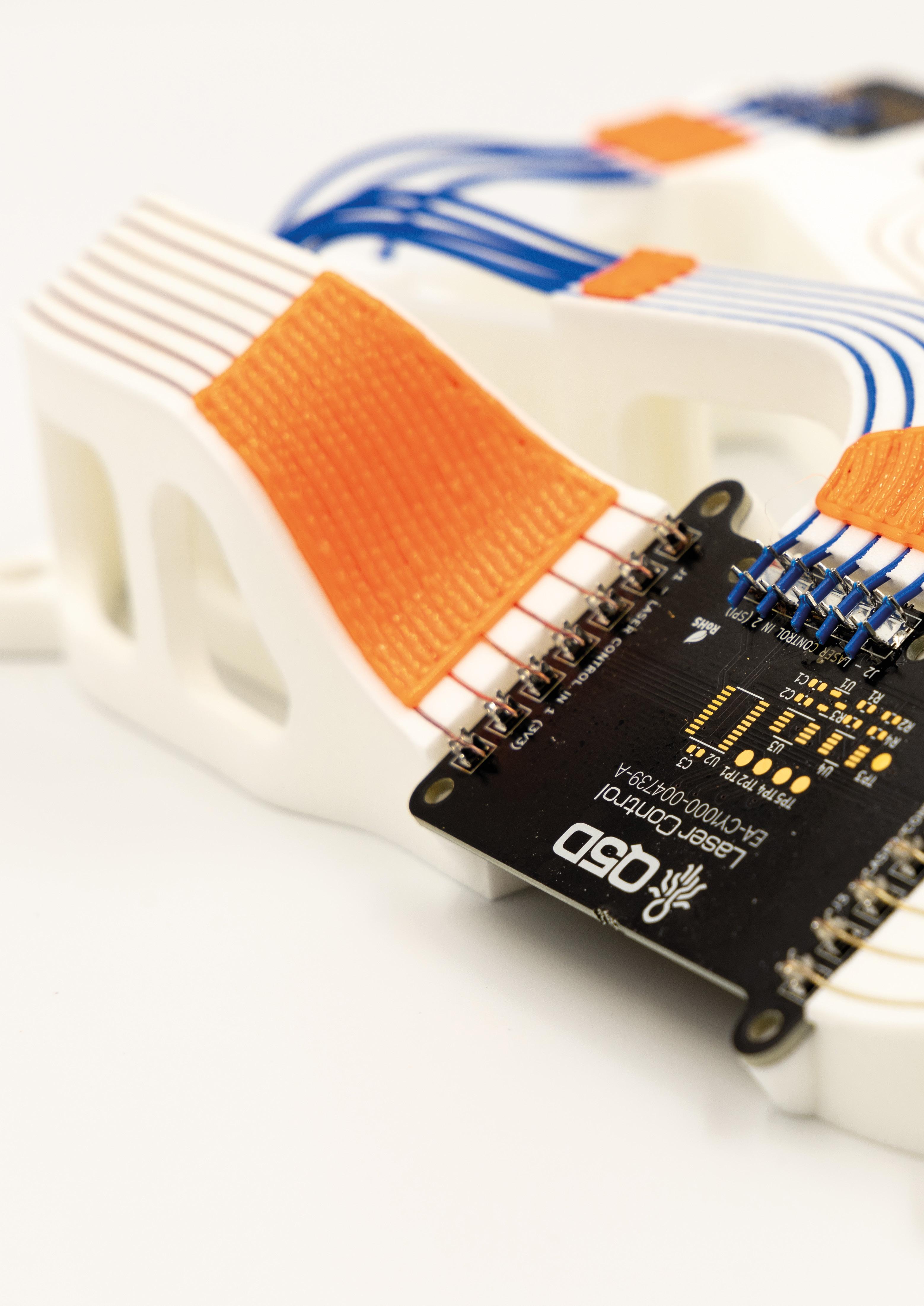
Project LiveWire, led by Bristol-based Q5D, aims to automate the manufacture of airline seating components and control systems by embedding wiring into the structures which make up these parts, helping reduce costs and build lighter, higher-quality components. Wiring in aircraft, cars and many consumer electrical goods is currently done by hand, making it an expensive and laborious process that is prone to errors and can cause failures and sometimes even fires. As part of this project, Q5D has

created a 5-axis robotic tool that can add wiring to a complex shaped component in a new, improved way.
The AMRC, part of the High Value Manufacturing (HVM) Catapult, was tasked with devising a proof-of-concept solution to calculate the position and rotation of a workpiece to enable the robot to fully automate the process of embedding wiring into them for use in the aerospace sector, as well as creating integrated validation processes for quality inspection.

“Our goal is to automate the largely manual processes currently employed to make wiring harnesses with a CAD/ CAM approach. Given the AMRC’s reputation in robotics and automation, they were the obvious partner for this project.”
Peter Todd, operations manager at Q5D
Edwin Anarcaya Roca, research engineer at the AMRC, said: “Q5D tasked the AMRC with making sure the position and rotation angle of the workpiece produced the best possible accuracy, while maintaining high repeatability and a fast computational process.
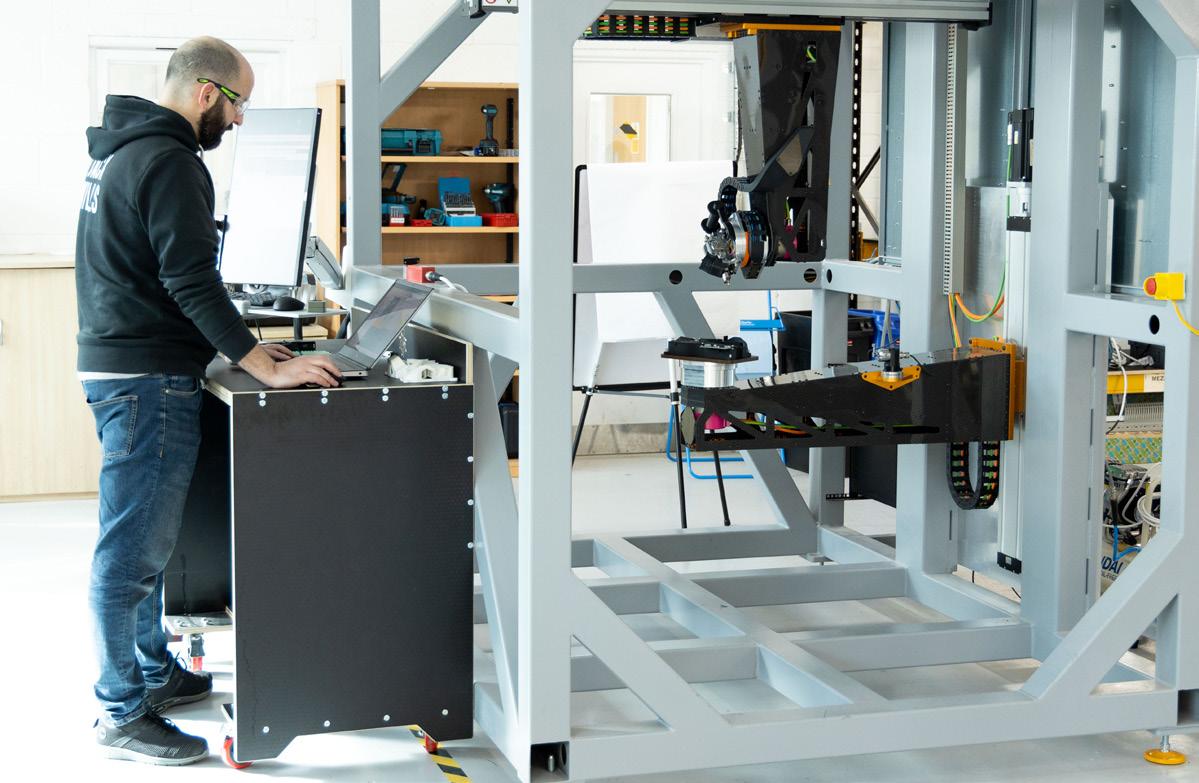
“To obtain this, AMRC engineers performed a number of trials to identify the right hardware and software that would be best suited and supported the company in implementing a proof-of-concept solution using a stereo vision camera.”
The benefits of automating the robot path using a vision system will provide Q5D’s robotic technology with greater flexibility to adapt to dynamic environments. Making automatic adjustments to the robotic path on the fly will increase productivity as it will decrease the manual programming needed to readjust the robot tool path.
Roca added: “The AMRC also implemented proof-of-concept computer vision solutions to automate the wiring inspection. These
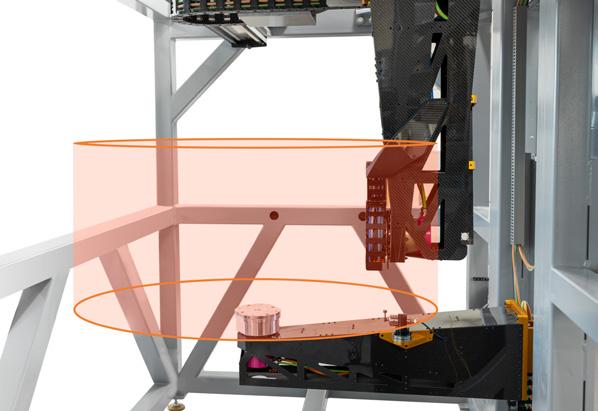
solutions include algorithms that detect defects such as wire breakages, crushed wires, stripped wire insulation, wires escaping from the track and incomplete track walls.


“The techniques used in these defect detection algorithms could lead to the development of a real-time, embedded wiring defect detection system integrated with the machine itself. Even though this project was looking at a pathway for use in the aerospace sector, this concept can be transferable to any robotics automation system.”
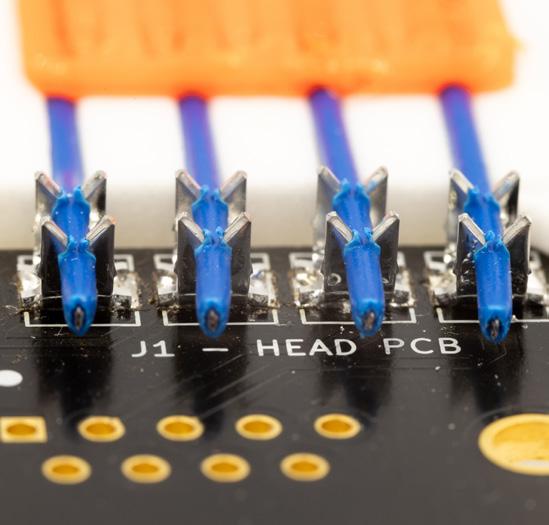
Chris Scraggs, theme lead for automation at the AMRC, said: “Working with Q5D Technology, the LiveWire project has been a great opportunity to develop innovative computer vision solutions for a really novel system. We’re looking forward to seeing where the technology develops, and we’re excited to take delivery of a Q5D machine for further testing.”
Peter Todd, operations manager at
Q5D, said: “Q5D are developing 5-axis robotic manufacturing cells to add wires, components and printed conductive tracks to complex parts from aerospace to consumer goods. Given AMRC’s reputation in robotics and automation, they were the obvious partner for this project.
“Our goal is to automate the largely manual processes currently employed to make wiring harnesses with a CAD/ CAM approach that will also create new product design opportunities, reduce weight, and use less space.”
The project, funded by Innovate UK as part of the ATI programme, is a collaboration between Q5D, the University of Sheffield AMRC, as well as other companies, including OnePLM, M-Solv and Safran.
Ten companies across South Yorkshire and North Wales, including industry giants Stanley Black & Decker and Magellan Aerospace, have signed up to NextGen, a pilot project by the AMRC to support the adoption of low-cost digital technologies and create digitally savvy engineers of the future. Chloe Rothenburg reports.
Research engineers at the University of Sheffield Advanced Manufacturing Research Centre (AMRC) sites in both South Yorkshire and North Wales have devised NextGen, an £867,000 project funded through the High Value Manufacturing (HVM) Catapult, to address the future of data science and current analytic skills shortages in the manufacturing sector.
“This is about driving productivity into regional manufacturing businesses through digital technology adoption and skills development,” said Ben Morgan, AMRC research director. “The programme will support the selected businesses to adopt low-cost digital technology and train apprentices and other digital champions to install sensors, and interpret the information being gathered to support informed business decision making.
“Gathering data and understanding the processes in more detail can help productivity as well as saving energy and reducing waste - it should be very beneficial for the businesses taking part.”
The AMRC, part of the national network of HVM Catapult research centres, has already secured ten businesses to take part in the project – including Stanley Black & Decker, Sterling Machining, ELE Advanced Technologies, ARMEG, CW Fletcher, Cooper & Turner, Sylatech, Magellan Aerospace, Henllan Bakery and the DRB Group – with six more in final talks to sign up.
Research engineers will support each
company to increase its productivity through data-informed decision-making; developing a sustainable, integrated and collaborative manufacturing ecosystem. NextGen will enable manufacturing businesses to leverage a competitive advantage by extracting meaningful insights from data, facilitating a move from a reactive to a predictive business model and help them to use this digital innovation to drive productivity and push them towards net zero.
To prepare the businesses for an increase in digital adaptations, the AMRC is working with Sheffield-based manufacturing analytics software
company FourJaw, which has simplified the Industrial Internet of things (IIoT), by creating the first easy-to-use and affordable machine monitoring system, designed to meet the demands of manufacturers.
The FourJaw team has been processing and gathering machine tool information from the selected companies already signed up to NextGen, enabling them to configure and send out the hardware, which once received and installed, will allow the companies to view their data almost instantly in the online FourJaw app.
 Chris Iveson, co-founder and CEO of
Chris Iveson, co-founder and CEO of
FourJaw, said: “FourJaw’s aim is to help manufacturers solve their two biggest problems: how do they find more work, and how do they manufacture that work on time, to spec, and within budget.
Our IIoT machine monitoring solution enables this by giving manufacturers the data visibility to improve their shop floor productivity by understanding the main causes of downtime.
“We’re delighted to have been chosen to be part of this programme and working alongside the AMRC and the manufacturers selected to demonstrate the value smart technology can provide
manufacturers of all sizes.”
FourJaw’s hardware is completely plugand-play, meaning it works with any and all machines, regardless of age or brand.
The machine data gathered enables manufacturers to drive productivity by providing data insight that allows them to understand the past, manage the present and optimise their production processes for the future.
Apprentices from the AMRC Training Centre, which provides apprenticeships to develop the engineering workforce of the future, as well as some of the companies’
own apprentices and young engineers, will also be given the chance to flex their tech muscles and help analyse the data. The idea is to spark their interest in data science, learn new skill sets and create digitally savvy engineers.
In addition, the AMRC is working with other local tech companies to contribute to the project, including WANDisco, the EyUp Skills Academy, Barnsley Digital Media and Razor, who are helping to deliver additional support to the chosen companies, as well as helping to organise two ‘hackathon’ showcases that will highlight the work that’s happened since the project launched in October.
Tom Hodgson, head of research for Factory 2050 at the AMRC, said the pilot scheme will be the next step in the AMRC’s roadmap for increasing the uptake of industrial digital technologies (IDTs) and data science in the manufacturing sector.
“The project will act as a showcase for how IDTs can benefit manufacturing organisations of all sizes and will show how digital tools are deployed across ten companies across South Yorkshire and North Wales,” Tom said. “Crucially, we will engage with the workforce to develop the skills necessary to fully utilise these cutting-edge tools to increase productivity.”

Andy Silcox, research director for AMRC Cymru, added: “NextGen is an exciting, unique, pilot programme that we at AMRC Cymru, believe will become an invaluable tool to guide manufacturers in North Wales in their journey through the fourth industrial revolution.
“It will firstly demonstrate the value of digital tools in the future of manufacturing, but more importantly, it will grow the skills within the partner businesses so they can make full use of those digital tools for years to come.”
“Gathering data and understanding the processes in more detail can help productivity as well as saving energy and reducing waste - it should be very beneficial for the businesses taking part.”
Ben Morgan, AMRC research director.
The Digital Manufacturing Support (DIMAS) project saw AMRC Cymru work with ten small and medium-sized enterprise (SME) manufacturers in Denbighshire, to deliver three-month individualised digital transformation projects.
These focused on improving product development, manufacturing processes and innovation strategy using smart technologies, including; digital simulations, automation, vision systems, metrology, dashboarding, mechanical testing and additive manufacturing.
The project was designed to help local businesses understand and realise the benefits of smart digital technologies, in partnership with Denbighshire County Council - and was funded by the Government through the UK Community Renewal Fund.
We’ve chosen three case studies that show the impact of these interventions: test kit distributor Bio-Check; touring caravan manufacturer Fifth Wheel; and KerbPower’s offroad EV charging port solution.
A luxury touring caravan manufacturer from St Asaph is rolling forwards, thanks to the benefits of a digital transformation project.

The focus of the work for The Fifth Wheel Company is centred around improving product development and manufacturing processes through smart technologies. In 2002, the business, set up by husband and wife Mervyn and Jenny Parry-Jones, designs and manufactures luxury fifth wheel and touring caravans.
Having seen the concept in the USA and importing an American fifth wheel, Mervyn found the size and build quality were not suitable for the European market and set out to build the first European-compliant fifth wheel caravan, a structure that has a fifth wheel hitch to tow.
Linking in with engineers from AMRC Cymru, helped the business roll forward with digital manufacturing.
Jason Murphy, operations director at AMRC Cymru, said: “It was a privilege to support
this family-run business to advance their digital maturity. The Fifth Wheel Company designs and builds outstanding products. A number of digital tools were proposed for the efficient capture of data during the
manufacturing process to help improve build efficiency, product quality and traceability.”
The support is helping The Fifth Wheel Company look to increase output and
take forward a better overall customer experience.
Gethin Whiteley, technical director for The Fifth Wheel Company, said: “The AMRC is helping us move towards digital manufacturing within our business. The initiative is providing specialist consultancy to allow us to improve our manufacturing processes and develop efficiencies.
“The intervention of the programme has refocussed our digital strategy by highlighting a range of areas where new
technology investment would significantly benefit the business.
“The overall outcome of the project is to increase our production quantities and improve customer experience. Through the integration of digital processes on the manufacturing shop floor communication, efficiencies and product quality will improve.
“Digital communications between our customers in the field and even directly with our product in the field will provide
invaluable data for improvements to our products.”
Looking at the support from the AMRC project, staff at the company feel it has refocused efforts to reap the benefits of working in the digital arena, with Gethin adding: “This is not only in terms of how we manufacture our products, but in how we reach out to new and existing customers making The Fifth Wheel Company experience more immersive, whilst streamlining the process as part of our overall business objectives.”
A digital collaboration is helping a St Asaph company push forward in lateral flow development.
Bio-Check, a specialist developer, manufacturer and distributor of test kits for food, healthcare and veterinary applications, received support from AMRC Cymru - whose engineers looked at the company’s onsite lateral flow tests.
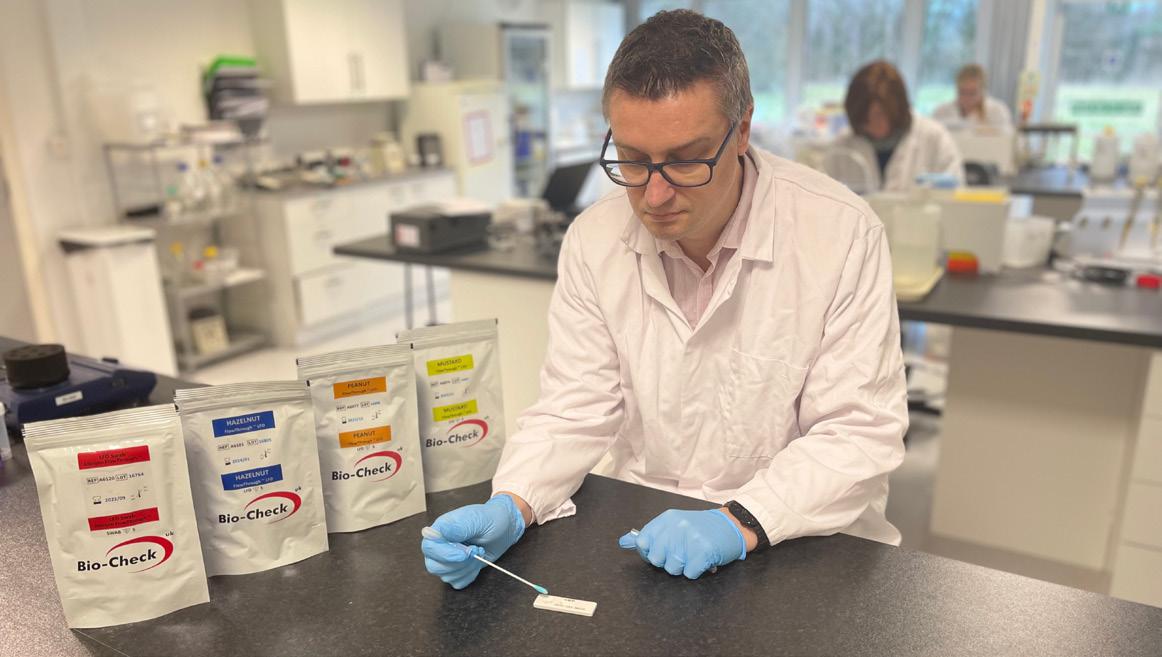
Richard Fielder, business manager for BioCheck, said: “We’ve been working on the scale-up of our manufacturing capability for an onsite veterinary lateral flow test for use by dairy farmers. We also have plans to develop our own range of lateral flow tests for detection of allergens in food manufacture.”
Dr James Allum, senior manufacturing research engineer at AMRC Cymru, a member of the High Value Manufacturing (HVM) Catapult network, said: “We supported Bio-Check through reviewing its manufacturing steps involved in lateral flow test production and generated a digital process flow map to identify process improvements.
“Discrete Event Simulation (DES), was also used to review opportunities for efficiency by comparing manufacturing processes data, against that hypothetically feasible through investment in semi-automated solutions.
“This research demonstrated potential staff time savings of up to 47 per cent, via semi-automation of some aspects of the production process. We also ran a workshop to develop methods for digitising paper-based documents and
support future digital process management to remove the time-consuming need to translate paper-based forms into a digital format.
“Additive manufacturing was used to develop replacement parts for lab-based components no longer commercially available, preventing the need for potential costly investment in a replacement system.”
Bio-Check (UK) started in 2012 and is part of an international consortium of companies, working in food safety, quality testing, training and consulting. They provide the skills and knowledge to develop and manufacture onsite lateral flow tests, laboratory tests for applications in food safety and quality supplied globally from Wales.
Richard added: “We believe these interventions will identify several areas for improvement, new equipment will provide some solutions, such as for pouching the tests (to ensure stability), to help reduce the labour intensive nature of the process and redirect resources.
“Implementing an e-documentation system will allow better accessibility and monitoring so data collected can be reviewed in real-time for better decisions.
“Shifting to a more digital-based business will help us better understand the characteristics of our processes so we can change in more predictable and sustainable ways, leading to sales growth and success, working with new partners and creating more skilled staff.”
A Denbighshire company’s innovative solution to boost electric vehicle (EV) charging has moved up a gear towards commercialisation, thanks to a digital collaboration with AMRC Cymru.
KerbPower Ltd, based in Ruthin, is working alongside engineers from AMRC Cymru to breathe green life into an on-street EV charging concept.
With the move to electric vehicles increasing every year, EV charging is becoming more noticeable at off street locations. KerbPower’s solution aims to provide a valid and economical way to tackle street charge stations with a unique, fully kerb-mounted electric vehicle charger (patent pending), that solves the tripping hazard and also pavement access issueswith the additional benefit of economy and ease of installation.
The digital transformation project has seen AMRC Cymru engineers give KerbPower the tools to move its design from concept towards reality.
Sam Roberts, inventor, designer and managing director of KerbPower Ltd, said: “KerbPower Ltd is currently engaged with AMRC Cymru to prepare a manufacturing
roadmap along with design specification and are providing guidance towards relevant external support for certification. We hope that local authorities will carry out trials throughout Wales, to ultimately benefit EV vehicle owners with no off-street parking.
“Whilst working alongside AMRC Cymru, we have also spoken to various car dealers who have said this system would be a potential game changer due to EV owners who don’t have off-road parking available to them and also more importantly those not considering owning EV’s due to the issue of not being able to charge at home.”
Dr James Allum, senior manufacturing research engineer at AMRC Cymru, which is a member of the High Value Manufacturing (HVM) Catapult network, said: “Through the application of our design and manufacturing expertise at AMRC Cymru, we were able to undertake important research, which considered both technical, such as mechanical, electrical and environmental requirements - as well as societal considerations, such as human factors, accessibility and interaction requirements to inform the design development of the KerbPower unit.
“Ultimately, this enabled us to develop a detailed design specification to facilitate the next steps in the development process of the KerbPower EV charging unit. This has a potentially significant impact in reducing the risks and complexity associated with the design development and future manufacturing of the device.”
Sam said his 40 years’ experience in the construction industry is what helped him spot a gap in the market.
“Having been heavily involved in the infrastructure of roads and bridges for many years led me to identify a gap in the market for an easy to install, on-street parking EV charging system,” he said.
“The concept has been developed and refined over a number of years to create the product that solves the issue of charging on street EV’s in not only a highly considered way but also in terms of economical installation and connection to the grid. It has been designed ‘specifically’ for EV owners/drivers who do not have off road parking available to them.”

“This has a potentially significant impact in reducing the risks and complexity associated with the design development and future manufacturing of the device.”
Dr James Allum, senior manufacturing research engineer at AMRC Cymru.
Technicians, engineers and apprentices from the University of Sheffield AMRC and AMRC Training Centre feature in a new national gallery at the Science Museum, celebrating the vital role technicians play in our everyday lives.

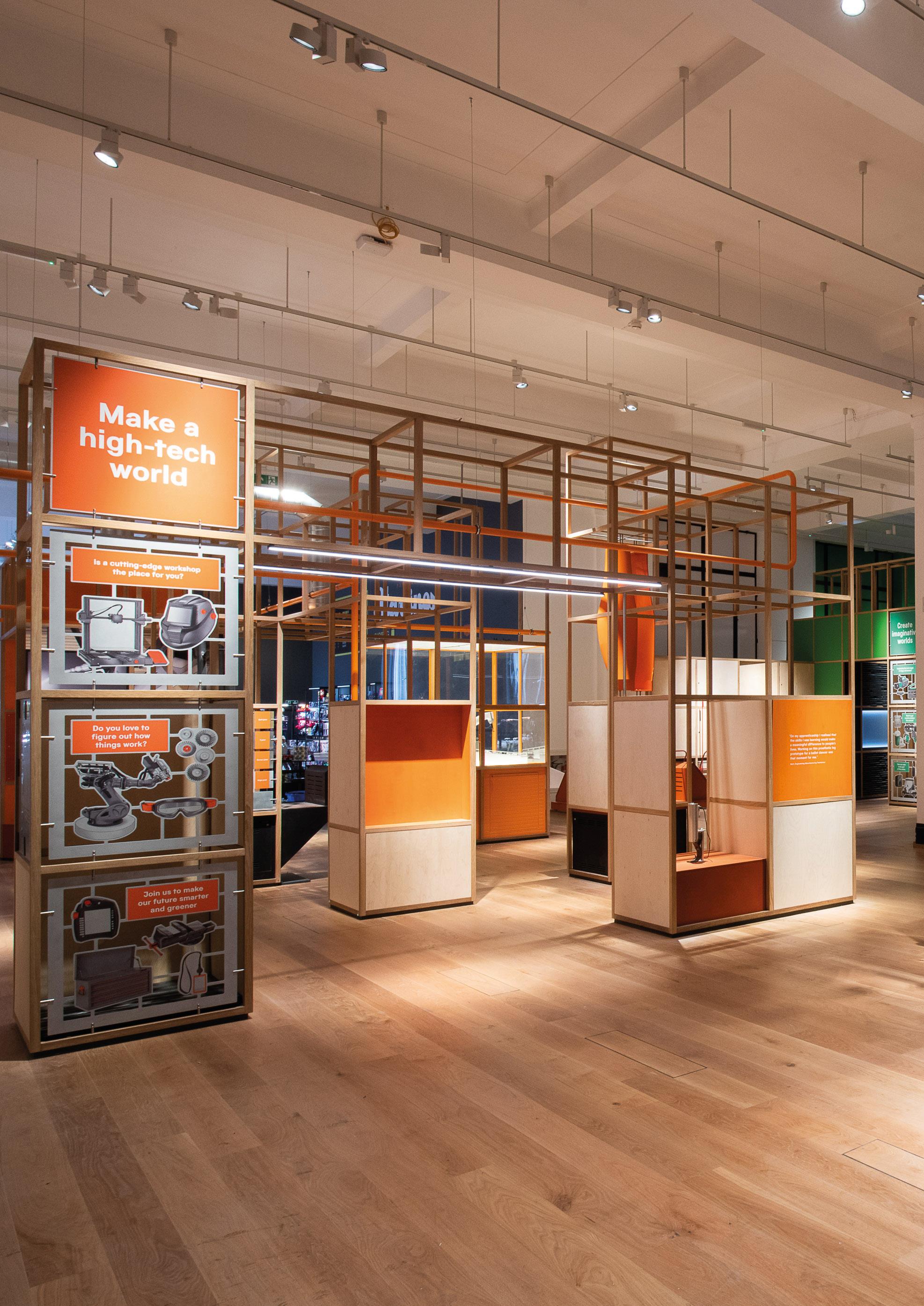
Technicians: The David Sainsbury Gallery is a free, interactive gallery designed with 11-16-year-olds in mind and seeks to change perceptions of technical careers and inspire tomorrow’s problem-solvers.


It allows young people to go ‘behind the scenes’ with technicians who work in advanced manufacturing, creative industries, health science and renewable energy to explore where they work, hear their inspirational stories and experience
what it is like to be a technician.
The University of Sheffield Advanced Manufacturing Research Centre (AMRC) helped bring the innovative gallery to life with large-scale illustrations of technicians and apprentices Rebecca Wright and Charles Oglesby at work; realworld stories from engineers including Bethany Cousins; and bespoke exhibits created with the expertise and support of technical leads David Kay and John Halfpenny. The AMRC and AMRC Training
Centre cast stars alongside a stellar line-up of other inspirational technical superheroes from Marvel Studios, the NHS and National Grid.
Rebecca Wright says it is an honour to be part of the gallery. She said: “As a technician at the AMRC, I helped make other people’s jobs easier and less timeconsuming, it’s a role that is constantly challenging and where you are forever learning new skills. The gallery is such a fantastic idea because now other people
can see what technicians do and understand why our work is so important.
“It feels amazing to know that others might be inspired by what I do; I hope that young people look at me and realise they can achieve something regardless of what they look like or their background. In some ways it’s overwhelming to think my face is going to be seen by thousands of people in a public gallery but it’s certainly a privilege.”
Visitors can use their skills to practise precision welding and weaving techniques like an AMRC manufacturing technician, control the film set lighting in a recreation of Shuri’s Lab from Marvel Studios’ blockbuster Black Panther, make lifesaving drugs as an NHS pharmacy technician or diagnose problems as a National Grid wind turbine technician.
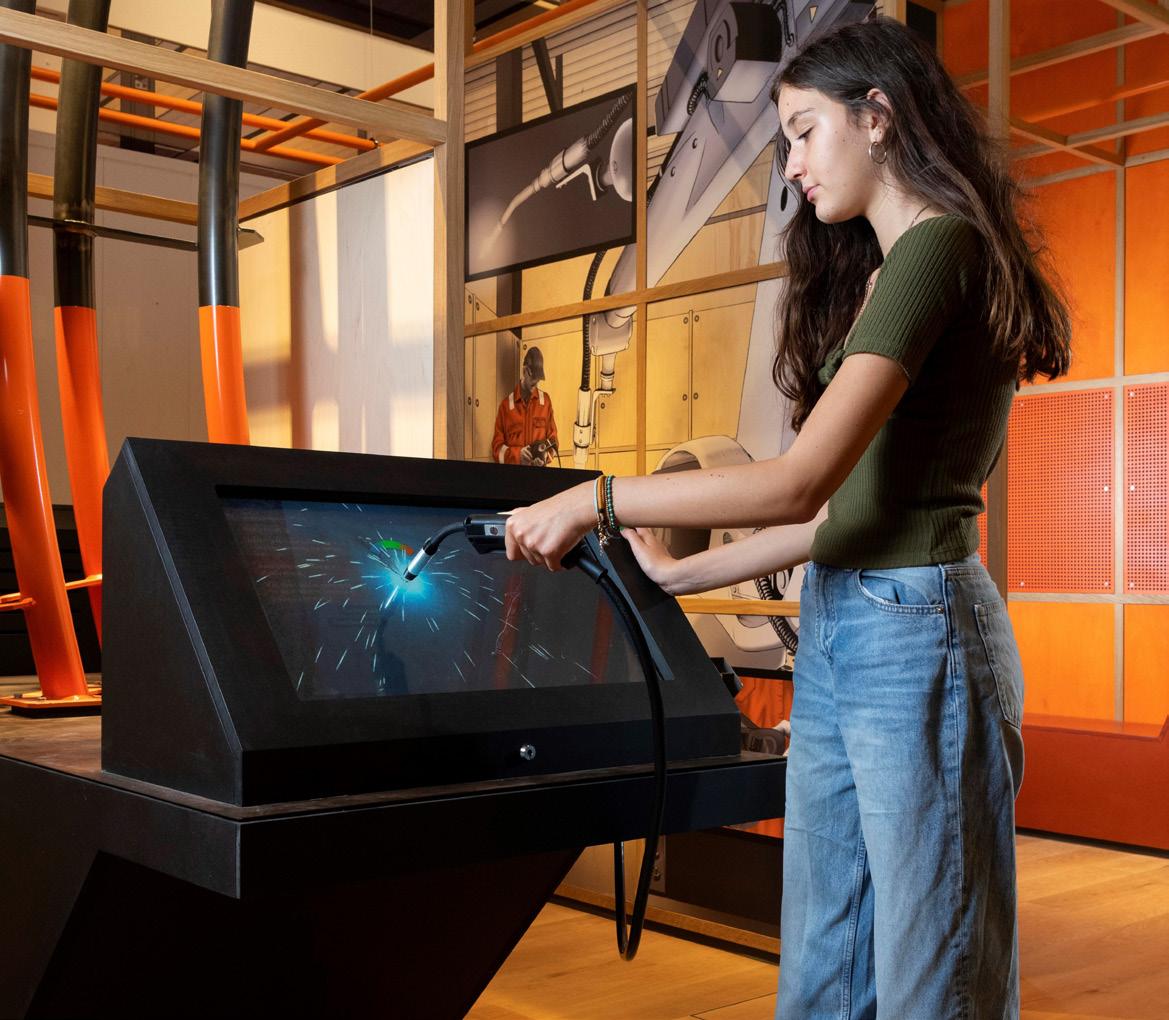
Professor Rab Scott, who is director of industrial digitalisation at the AMRC, attended the launch event at the gallery. He was blown away by what he saw and says it is a fantastic way to capture the imaginations of young people and inspire them to pursue a career as a technician. He added: “For the AMRC to be alongside the likes of Marvel, the NHS and National Grid is an immense source of pride for us. It speaks to the role that advanced manufacturing plays in everyday lives across the UK.
“Technicians are absolutely key to moving forward. They are the people that take proven techniques and procedures and apply them to big industrial challenges, to improve productivity, to improve sustainability and to help us reach net zero. This gallery really does put a welldeserved spotlight on the vital role our country’s technicians play.”

Although an estimated 1.5 million technicians currently work in the UK - from archaeological technicians to veterinary nurses - too few young people aspire to be technicians or know about these roles and the pathways to them. However, demand for these skills continues to increase, with 800,000 technicians and apprentices desperately needed across the STEM (science, technology, engineering and maths) sector.
The Science Museum says recent research by the Gatsby Charitable Foundation illustrates the need for the gallery and its
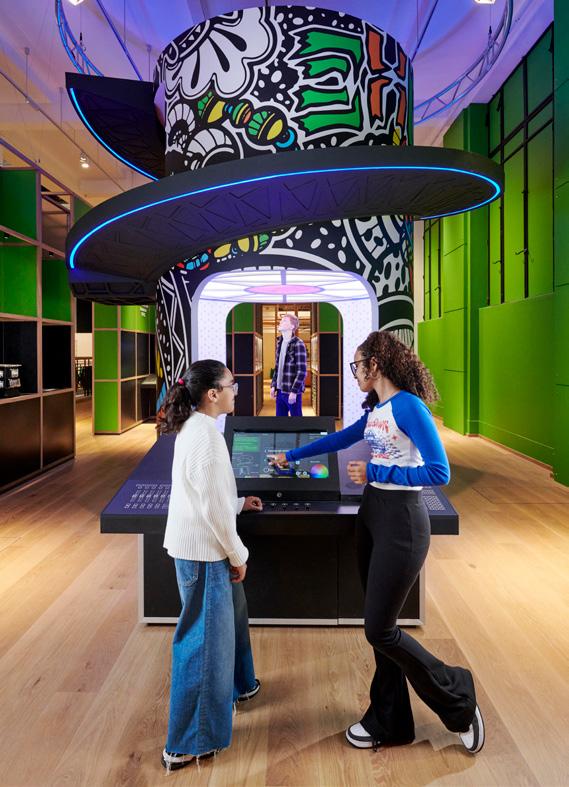
“It feels amazing to know that others might be inspired by what I do; I hope young people look at me and realise they can achieve something regardless of what they look like or their background.”
Rebecca Wright, former AMRC apprentice technician.All images credit: The David Sainsbury Gallery © Science Museum Group
potential impact, with findings showing that once young people know more about technicians, 71 per cent feel that becoming a technician is achievable. It is hoped the gallery will help address demand for these important roles, providing a one-of-a-kind space for young people to explore 100 different technician roles, discover more about the varied routes into STEM careers and to imagine themselves as technicians.
Sir Ian Blatchford, director and chief executive of the Science Museum, said: “Technicians are long overdue their time in the spotlight as one of the country’s most vital teams, driving economic growth in an amazing range of sectors. In generating excitement among 11-16-year-olds about technical roles, and challenging outdated perceptions, this interactive gallery encapsulated our core mission of inspiring futures.
“We are hugely grateful to David Sainsbury and the Gatsby Charitable Foundation for
enabling the Science Museum to shine much needed light on these important careers advice and the chance to shape a greener and more diverse economy.”
David Sainsbury said: “The purpose of the Technicians gallery is to tell young people that the country now has, for the first time, a high-quality system of technical education, and to showcase the personally fulfilling and economically critical jobs which this system can enable them to take up.
“It has been made possible by many people, including Sir Ian and his team at the Science Museum, the many industry partners involved and my own team at the Gatsby Foundation. I would like to thank them all for the creativity and enthusiasm they have brought to the project.”
On entering the Technicians gallery, visitors are greeted by a large sculpture: a beautifully crafted kit of parts showcasing
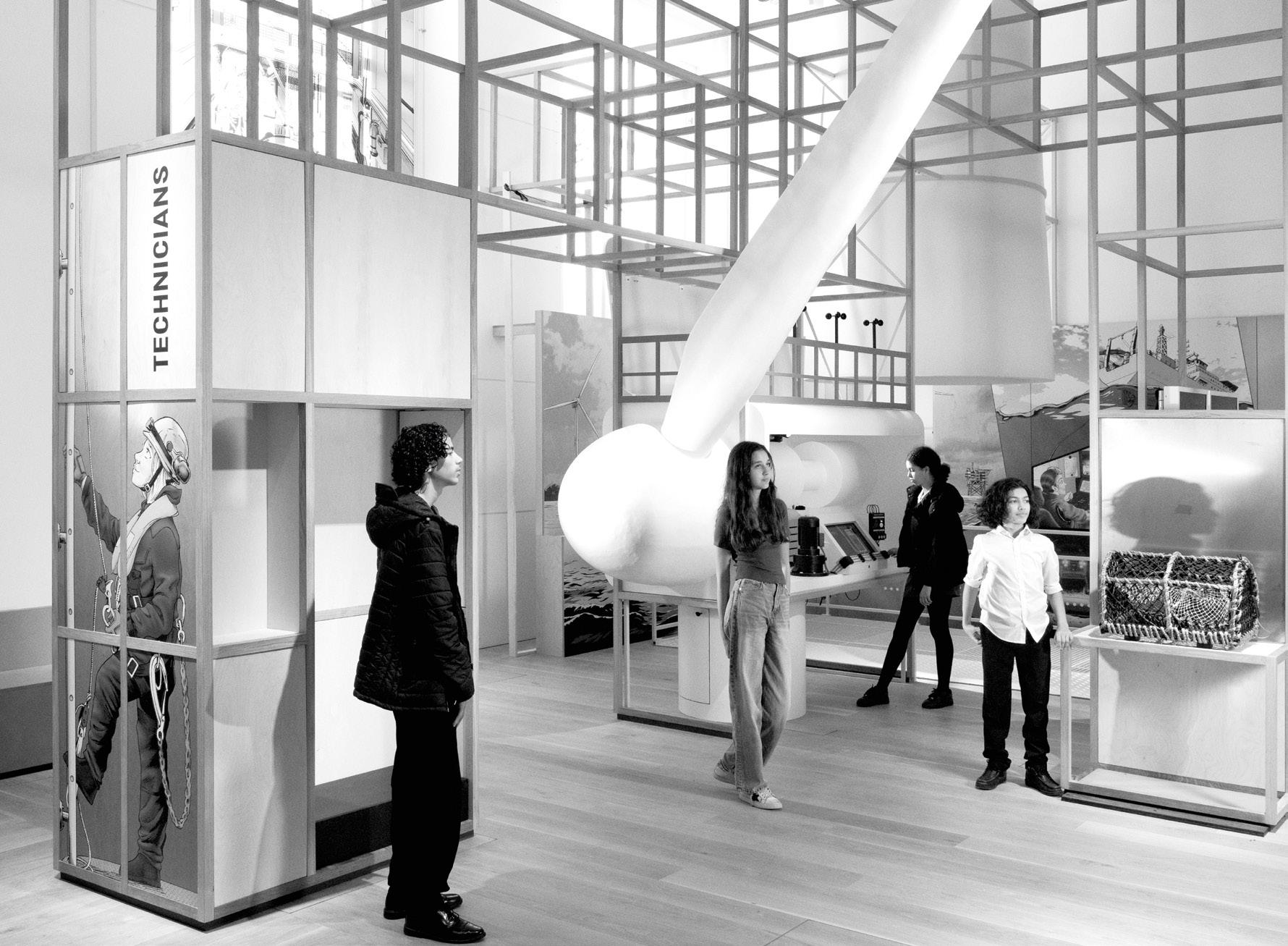
the critical tools and equipment technicians need to do their work. As visitors move around the five areas of the gallery, the world of technicians is brought to life through large-scale illustrations featuring technicians in a wide range of workplaces.
Interactive exhibits invite visitors to experience the work of technicians by completing a variety of tasks that technicians perform, guided by a senior technician mentor. Visitors can also touch objects made and used by technicians, from the safety harness work by technicians high up on a wind turbine, to the prosthetic leg made for a ballet dancer by engineering manufacturing technicians at Imperial College London. For more information, visit the Science Museum website.
Apprentices who had the prized opportunity of a visit to McLaren’s flagship technology centre described the trip as being ‘one of the coolest things they had ever seen’ and was ‘an amazing tour that money couldn’t buy’.

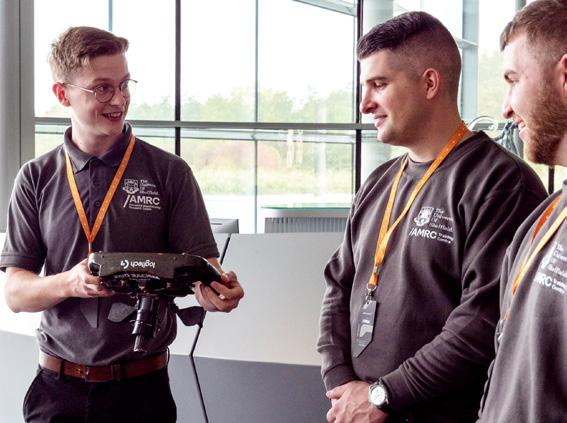
The group of ten were finalists in the University of Sheffield AMRC Training Centre’s Apprentice of the Year Awards 2021, with the postponed ceremony being held last year. Part of their prize was a ‘once in a lifetime’ trip to the headquarters of McLaren Racing and McLaren Automotive, which was gifted to them by the awards’ headline sponsor, Stanley Black & Decker and its offshoot manufacturing company, DEWALT.
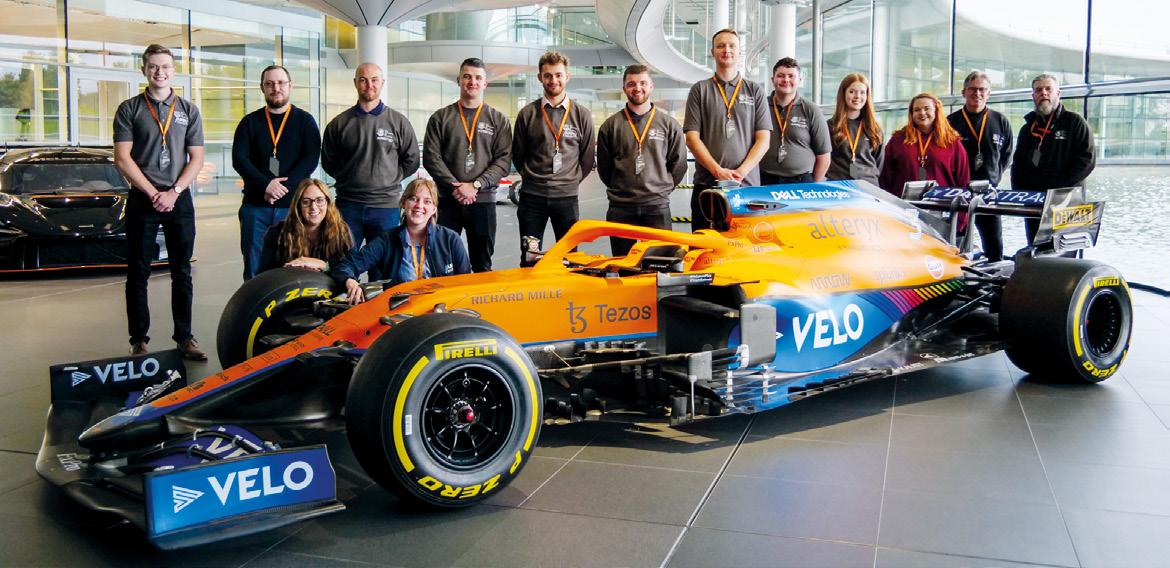
Kate Todd-Davis, a manufacturing engineer for Rolls-Royce, who was crowned the overall ‘Apprentice of the Year’ at the awards, said: “The McLaren Technology Centre is a very impressive, world-class manufacturing facility and it’s one of the coolest places I have ever seen.
“It was fascinating to see the evolution of Formula One (F1) cars on display and having the opportunity to go into the manufacturing areas and see the different technologies they use.”
From the outside, the Woking-based facility has a picturesque green landscape surrounding it – reminiscent of a scene taken straight from a Jane Austen novel –and from above it looks like the Chinese symbol of Yin and Yang. But it is on the inside where heaven on Earth can be found for car fanatics.
As soon as you set foot through the door, visitors are greeted by a sea of colour in
“My highlight of the tour was getting to hold Daniel Ricciardo’s steering wheel. It was a visit like no other and will be hard to top.”
Jack Gascoigne, a project engineer at the AMRC.